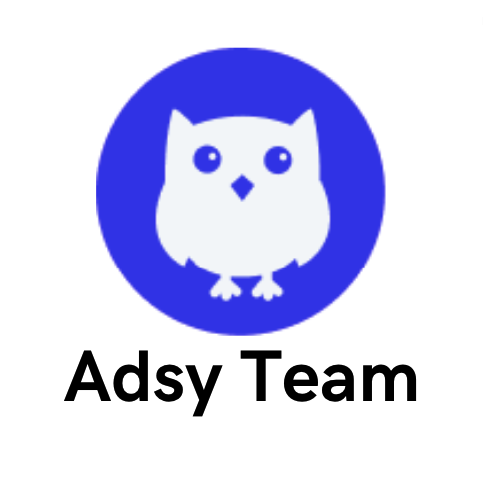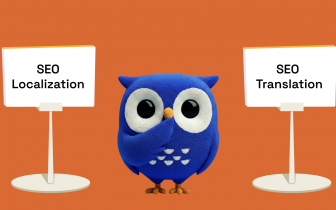How to Rank in AI Overviews: 8 Proven Tips to Get Featured

“Oh great, now I’m competing with the algorithm itself.”
If you are an SEO expert or a content marketer, there's a big chance this was your first thought when you discovered that Google rolled out AI Overviews.
Your sentiment is very understandable. And yet, here’s something for you to think about:
AI answers can be your biggest traffic boost in 2025. No jokes!
The thing is, when your content gets featured in those AI-generated summaries, you own the search results. Your brand appears right in the spotlight of Google’s most powerful new feature.
- But how can you actually get cited there?
- How do you create content that Google’s AI chooses as its source?
That’s what this guide is all about. So, let’s get right into it.
How do Google's AI Overviews work?
We won’t give any definitions of what an AI Overview (AIO) is because you’ve definitely seen one of these:
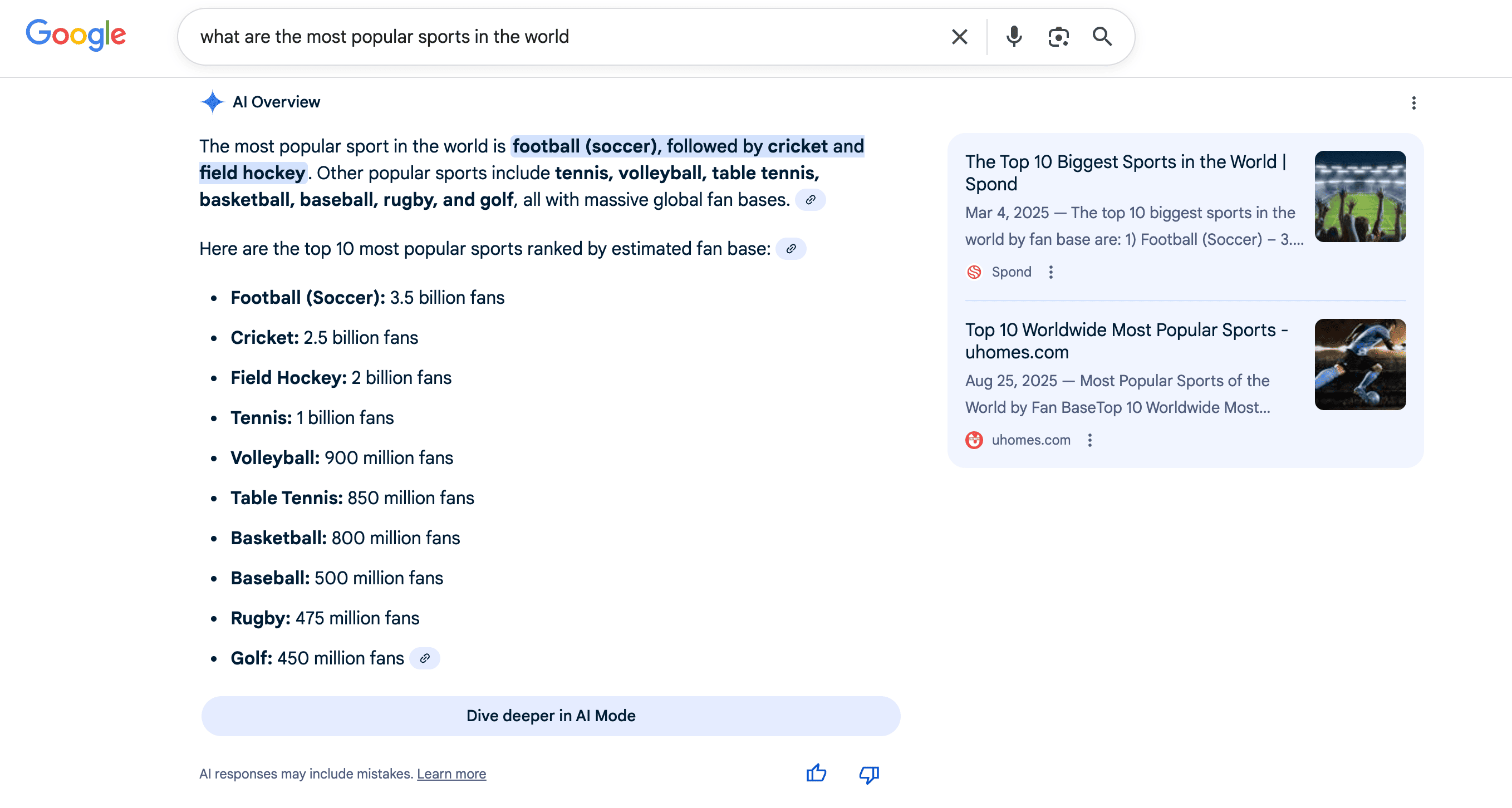
This feature is quite easy to define, but it doesn't mean its mechanism is plain. In fact, this is a really complex process, and it’s still unclear exactly how AIOs work.
But overall, AI summaries operate through the following three steps:
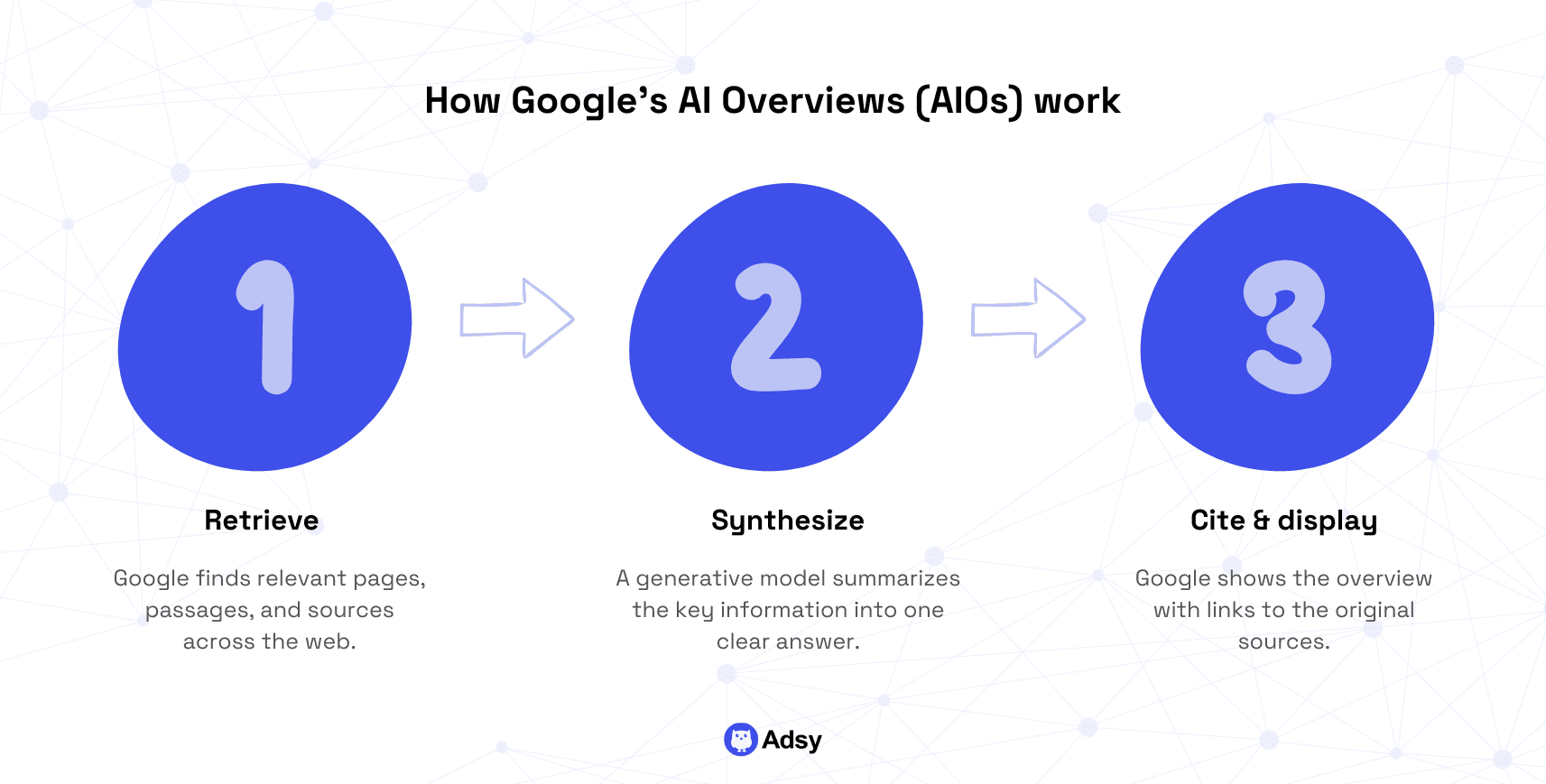
Step 1: Retrieval
Google first goes through the indexed content to find “candidate pieces” that are relevant to the query. This is not strictly “top-10 blue links”.
Google’s retrieval models can surface pages, passages, images, videos, and even structured data that match parts of the query.
The official Google guidance describes the process behind its AI features as “combining web signals with models to produce answers”.
Step 2: Synthesis
Synthesis is a generated summary part. The content Google’s AI collected in the first step is now passed to a generative model.
Then, the model sort of "filters" and synthesizes all the information into a concise overview.
This is an example of Retrieval-Augmented Generation (RAG). The model takes the information it got and reduces hallucinations to improve accuracy.
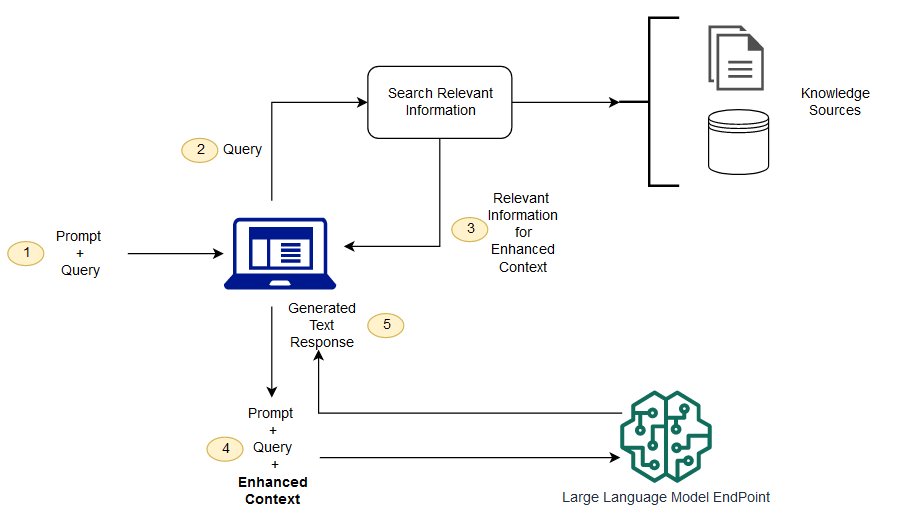
Source: AWS
Step 3: Attribution and UI
Finally, Google gives you the generated answer in an “AI Overview” box that includes citations and clickable links to its sources.
Google includes a short list of references it synthesized.
But how many and which ones can vary by query. We also don’t yet know whether all the sources used are cited. So, it’s also important to remember that.
How does Google choose sources for AIOs?
Let's also address the doubt all content marketers have (we’re on your team, too): “What sources does Google use?”
- Authoritative pages: Similarly to “normal” search results, Google often looks at domain authority and topic authority, especially when the query is direct. But being on the first page doesn’t mean you’ll show up as a source in AIOs.
- Parts of your content: Sometimes, Google cites a specific section, stat, answer, or paragraph rather than the whole page. This helps it give exact answers. So, the more related questions you address, the better.
- Fresh information: Overviews prioritize up-to-date pieces. That’s why it’s important to update your content often, especially if the topic is time-sensitive.
- Multimodal sources: Increasingly, videos and other media show up as source material for some AIOs. But of course, this will depend on your niche and keywords. You can even test it yourself.
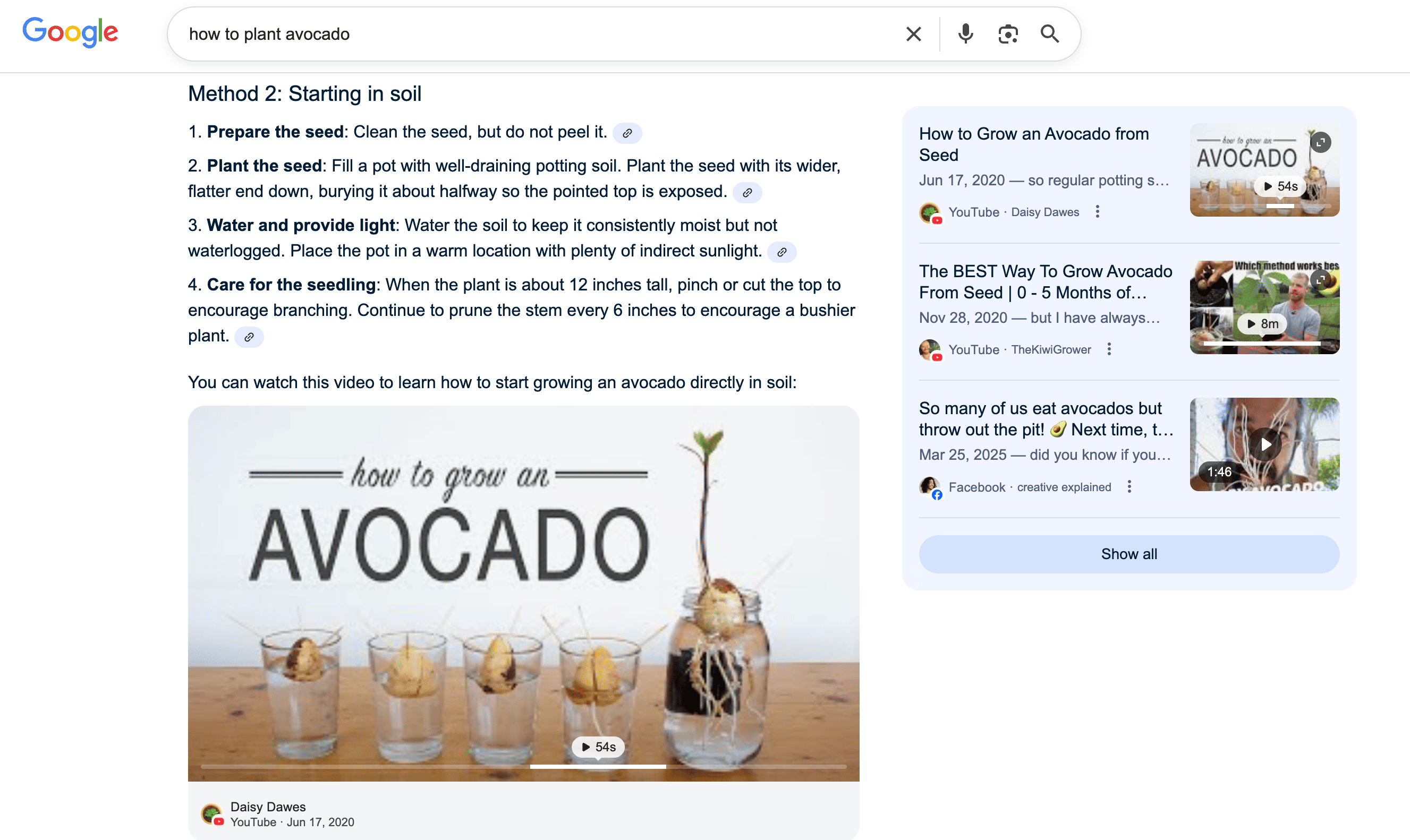
Important nuance: Google’s models often pull content from high-authority sites even if their content isn’t the deepest. That’s why strong SEO can definitely help you.
Does every query have an AI summary?
No, Google doesn’t show AI Overviews for every query. At least not yet.
Based on Google’s guidance and recent industry studies, AIOs appear most often when queries are:
- Informational and complex: Multi-part questions, comparisons, “how-to” with nuance, etc.
- Ambiguous or exploratory: Queries where a short summary is genuinely helpful.
- Action-oriented searches: Searches where users need a quick, condensed instruction rather than just a list of links.
In other words, if your target queries are short transactional keywords (e.g., “buy blue shoes size 10”), AIOs for them are less common today.
But if they’re targeting something informational like “which agile framework should we use for fintech startups,” that’s exactly the kind of query AIOs love.
In fact, according to Semrush research, almost 82% of desktop and 76% of mobile AIOs target informational keywords.
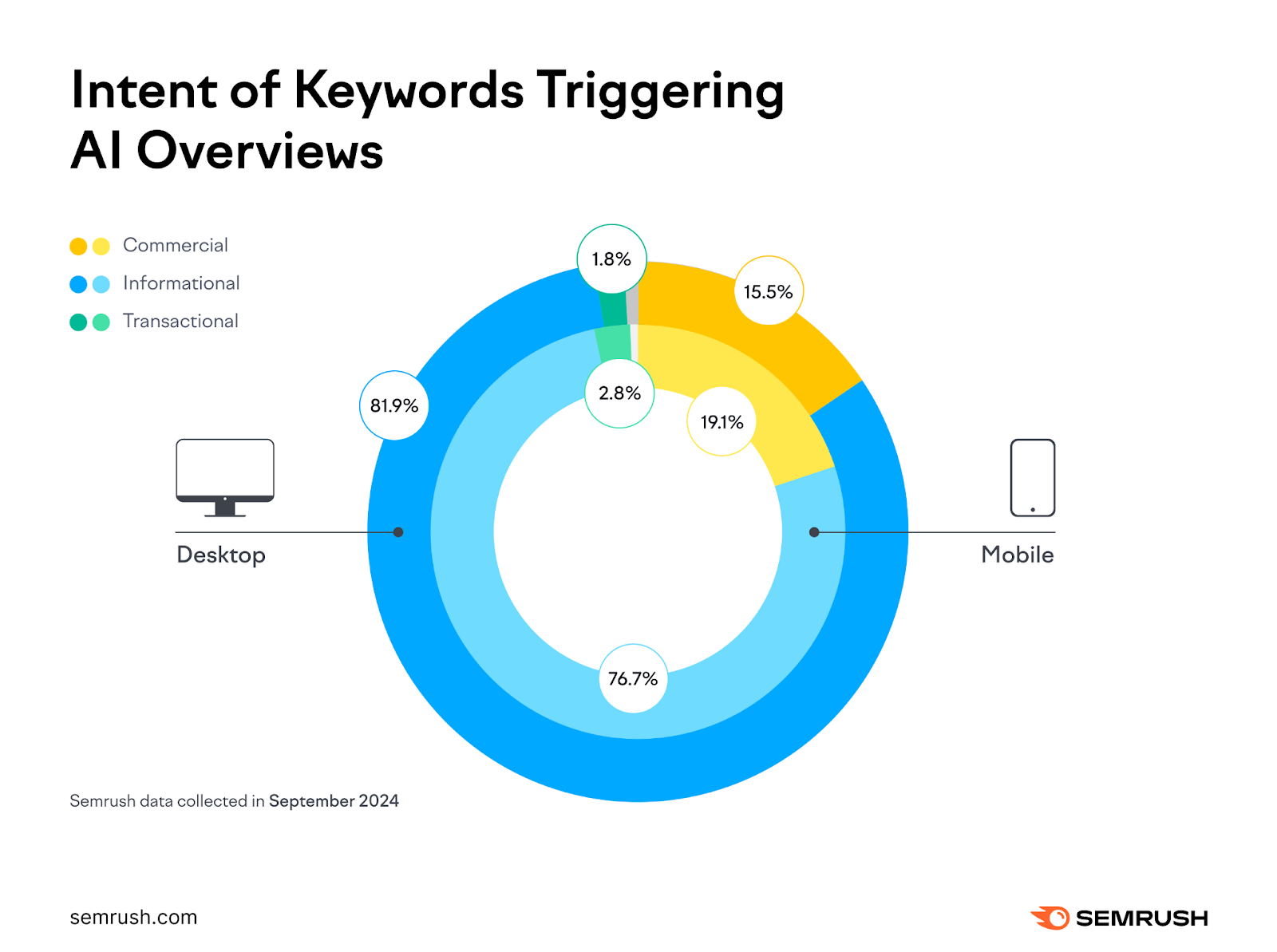
Source: Semrush
Are these any different compared to featured snippets?
First of all, you likely see less and less of these little boxes (aka featured snippets) when googling.
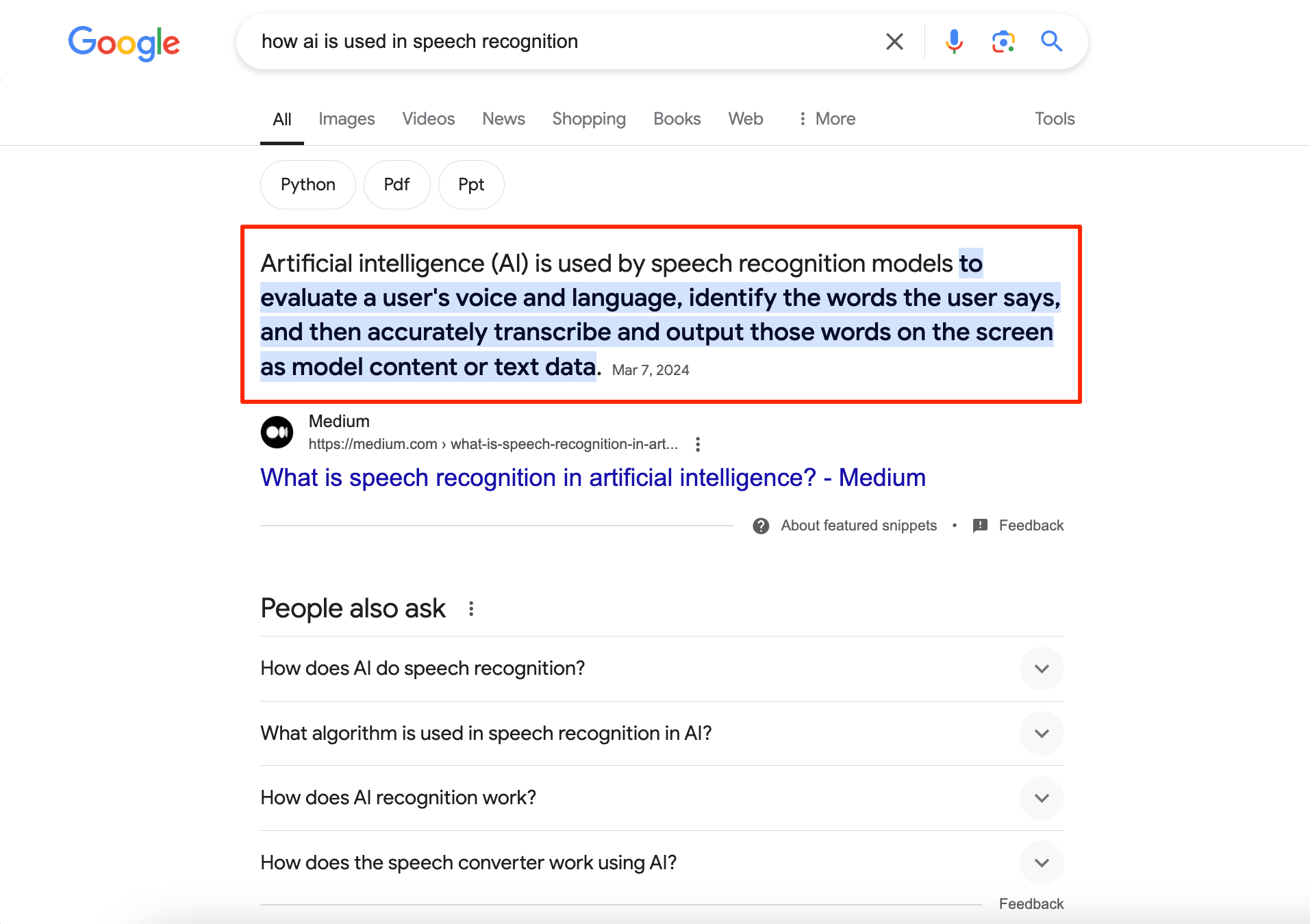
Source: SE Ranking
Frankly, for this blog post, we’ve been checking multiple search queries to see if we can find a featured snippet instead of an AI Overview. And well, out of 50+ searches, we found zero (literally 0) featured snippets.
According to different sources, anywhere between 70-90% of featured snippets have been replaced by AI Overviews as of 2025. Of course, it will depend on your niche and region. But still, it’s impressive.
So, if you’re still optimizing for featured snippets, it’s time to change your priorities.
How are these two different, though?
- Source attribution. Featured snippets pull content from one page (single source) and give it a visible credit. AIOs synthesize content from multiple sources and display multiple citations.
- Traffic dynamics. With featured snippets, the highlighted page often experiences a traffic boost. Why? Just because it is clearly attributed, and users click through. So, how is AIOs different? It actually may reduce direct click-through rate (CTR) for some queries (especially informational) because users get comprehensive answers right away.
- Query types. Featured snippets often answer simple questions or definitions, like “what is X?” and “how to do Y?” But AIOs can also target more complex, multi-part, conversational queries.
- Content format. Featured snippets “reward” rather small passages. But if you want to optimize for AIOs, you need way more depth to begin with. We are talking about authority and a more elaborate content structure.
But there is also good news: if you’ve been optimizing for the classic “position zero” effectively, ranking for AIOs will generally be much easier.
Besides, AIO optimization has a lot in common with voice search optimization. So, many tips we’ll share below will apply to both.
What types of content get selected for AIOs?
… or what content you should produce to get into that AIO spotlight. Let's find out.
Informational how-tos, educational, or “what is” content
Google’s AI Overviews rely heavily on valuable data that helps users learn or do something fast. So, “how-to” guides, FAQs, and tutorials fit perfectly here.
After all, these are also the things we (aka humans) find useful.
But to make this content actually valuable and AIO-friendly, you need to make your language very clear and easy. We’ll get into all the best practices later on, but for now, let’s cover the basics.
To optimize your informational and educational content for AI summaries, try to structure your article like a good manual:
- Write in short paragraphs.
- Start with a 1-sentence definition or overview.
- Use bullet points or numbered steps to create clarity.
- Include code samples, visuals, or mini-checklists when explaining technical or creative processes.
This makes your page “AI-readable.” Google’s AI summaries prefer content that mimics human teaching. It should be direct, logical, segmented, and contextually rich.
For example, a blog post titled “How to Increase Mobile Page Speed (11 Optimization Tips)” that includes technical SEO explanations and actionable strategies gets a thumbs up.
And it is highly likely to appear in AI search results for related user queries (if everything else is well-optimized).
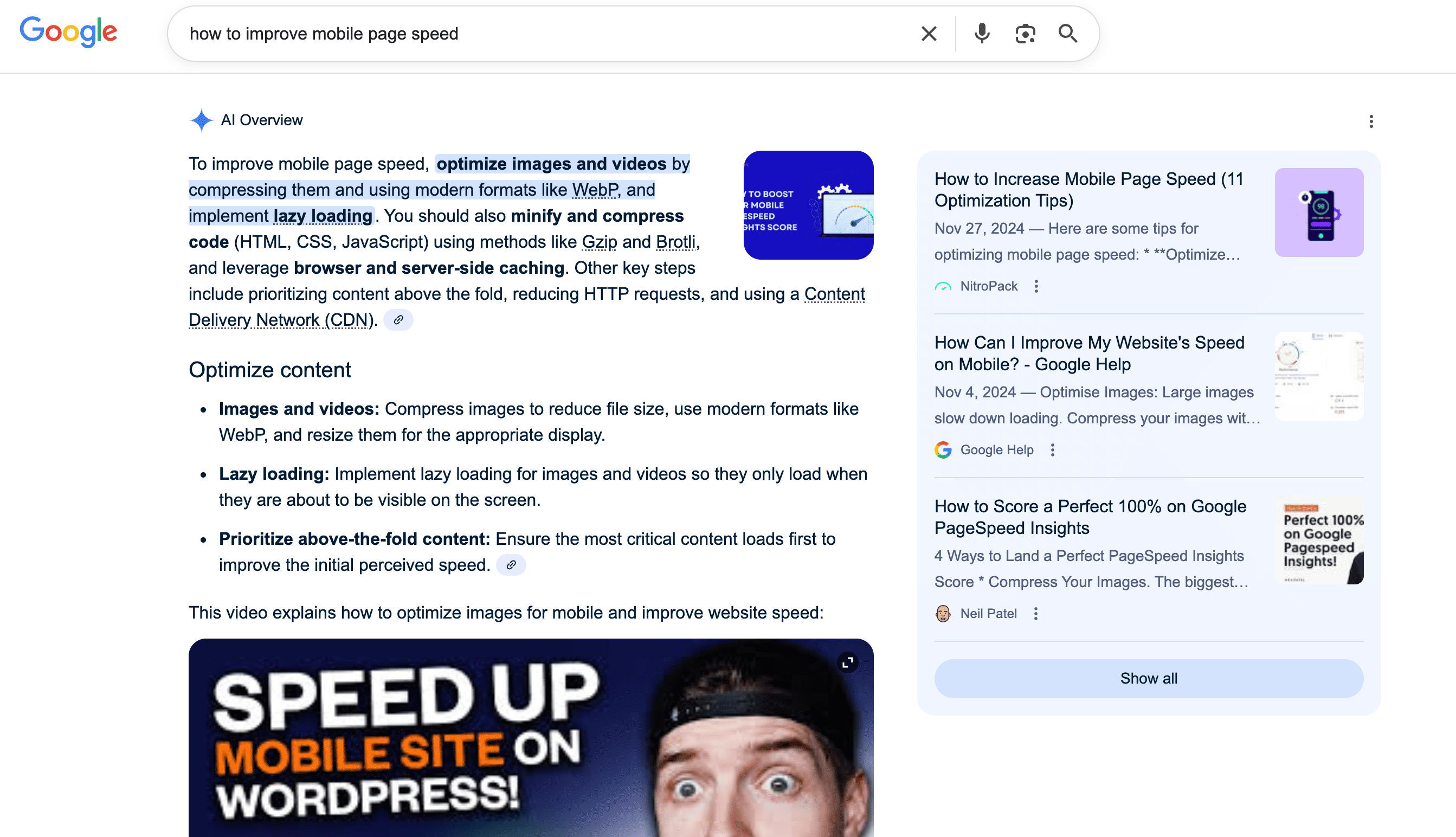
“Comparison” or “vs.” type content
Content that compares different options (“X vs. Y”) is a classic trigger for AI Overviews. It might be “WordPress vs. Webflow” or “SEO vs. PPC”. These formats give Google’s AI algorithms extractable contrasts.
Why do they work?
- They help AI understand relationships between entities.
- They provide concise answers in bullet-point form or tables.
- They align naturally with search intent when users evaluate or decide.
Tip: Use bold labels like “Pros,” “Cons,” “Advantages,” “Disadvantages,” “Verdict,” or “Best for,” etc., and add relevant links or deeper content on your site.
This not only increases user engagement but also gives AI search systems structured passages to cite.
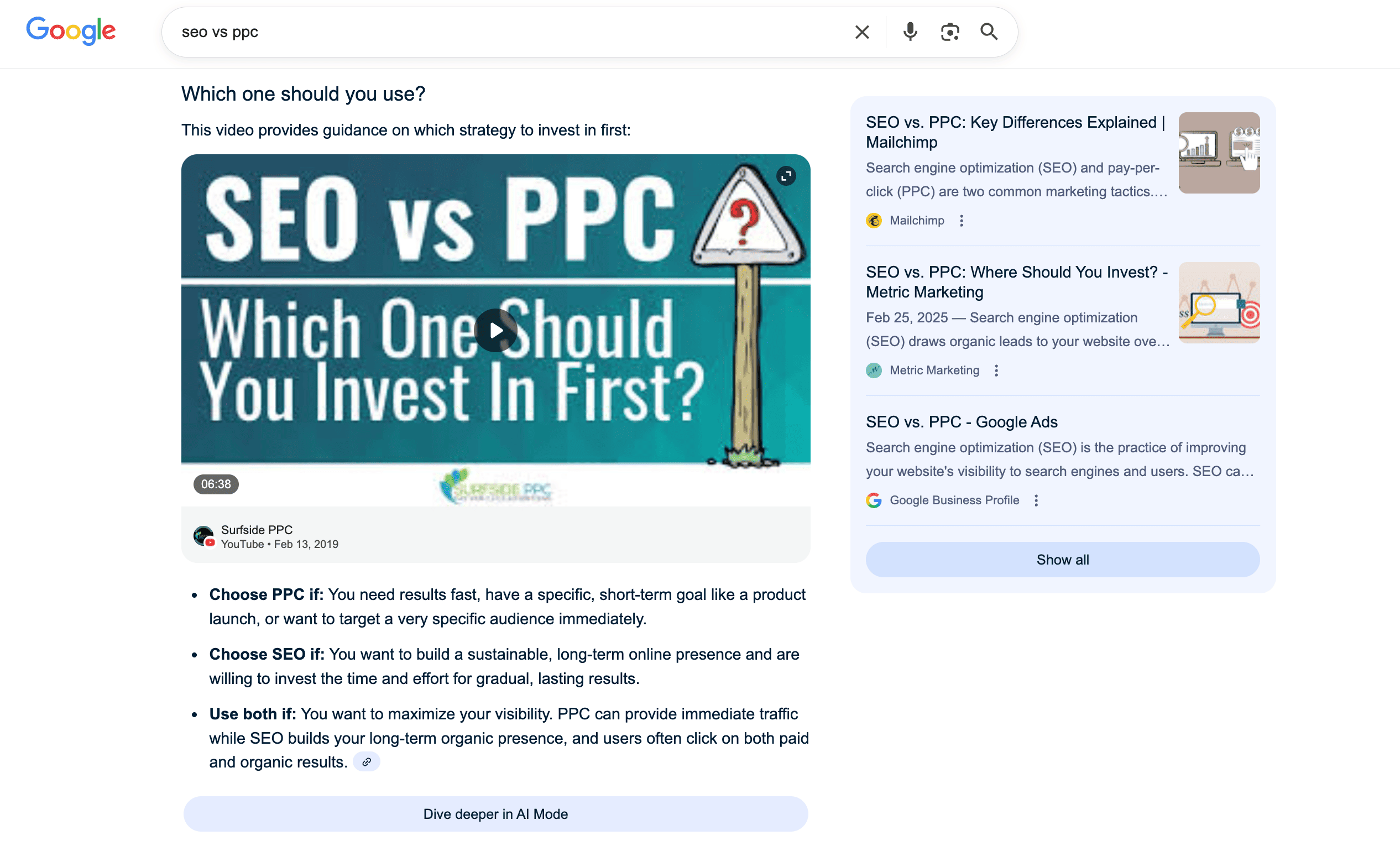
Data-rich or stat-based content
In the AI-driven search landscape, factual accuracy is the true power. Pages packed with up-to-date data analysis, credible sources, and structured data will always win.
Why? Because AI models seek verifiable and trustworthy information, they can summarize without any major errors.
This is exactly why, when possible, your content should include:
- Current statistics with trustworthy source links that are relevant to your niche.
- Short “Key Stats” or “Data at a Glance” sections for fast comprehension.
- Original research (if your domain is authoritative enough).
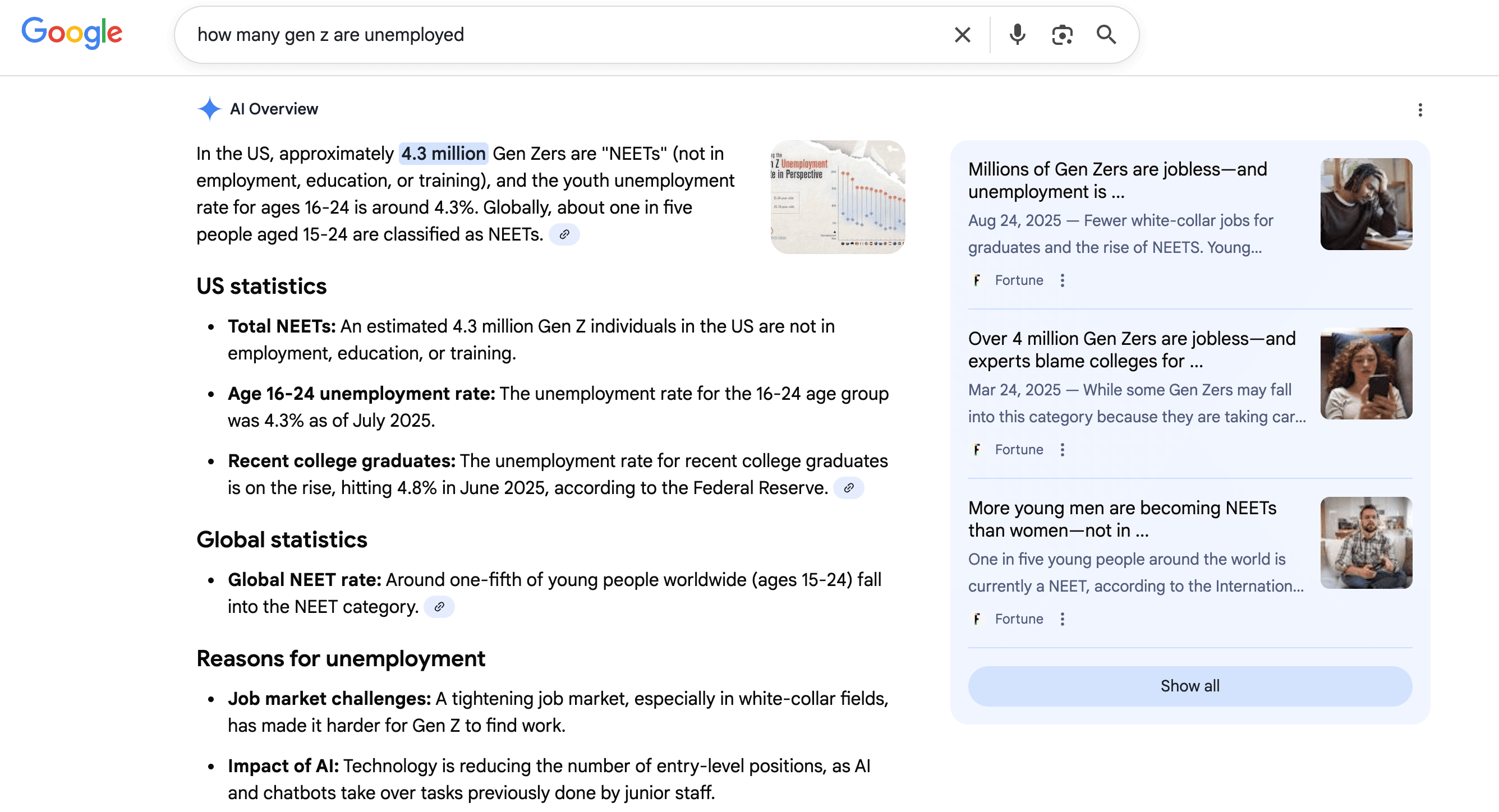
Scannable formats
You might love storytelling, and so do we. But AI Overviews love structure. Yeah, we know…
Google’s AI search systems always favor content that’s scannable, broken into short paragraphs, and uses bullet points often.
Pages that rank tend to:
- Lead with a concise answer (often under 40 words).
- Use clear, easy-to-understand subheadings for every section.
- Maintain strong, logical content structure and internal linking.
So, for example, if your goal is to rank for AIOs, avoid going for story-like definitions and metaphors:
- If your H2 is “What is CRM?”, then your first sentence should be “CRM is…,” not a story about how, when you started in marketing, your only system was a notebook.

- The same way your subheadings have to be clear and action-driven to rank in AI search. For example, “Do XYZ,” “Start with XYZ,” not something poetic or allegorical like “The giant in the Lilliput world”.
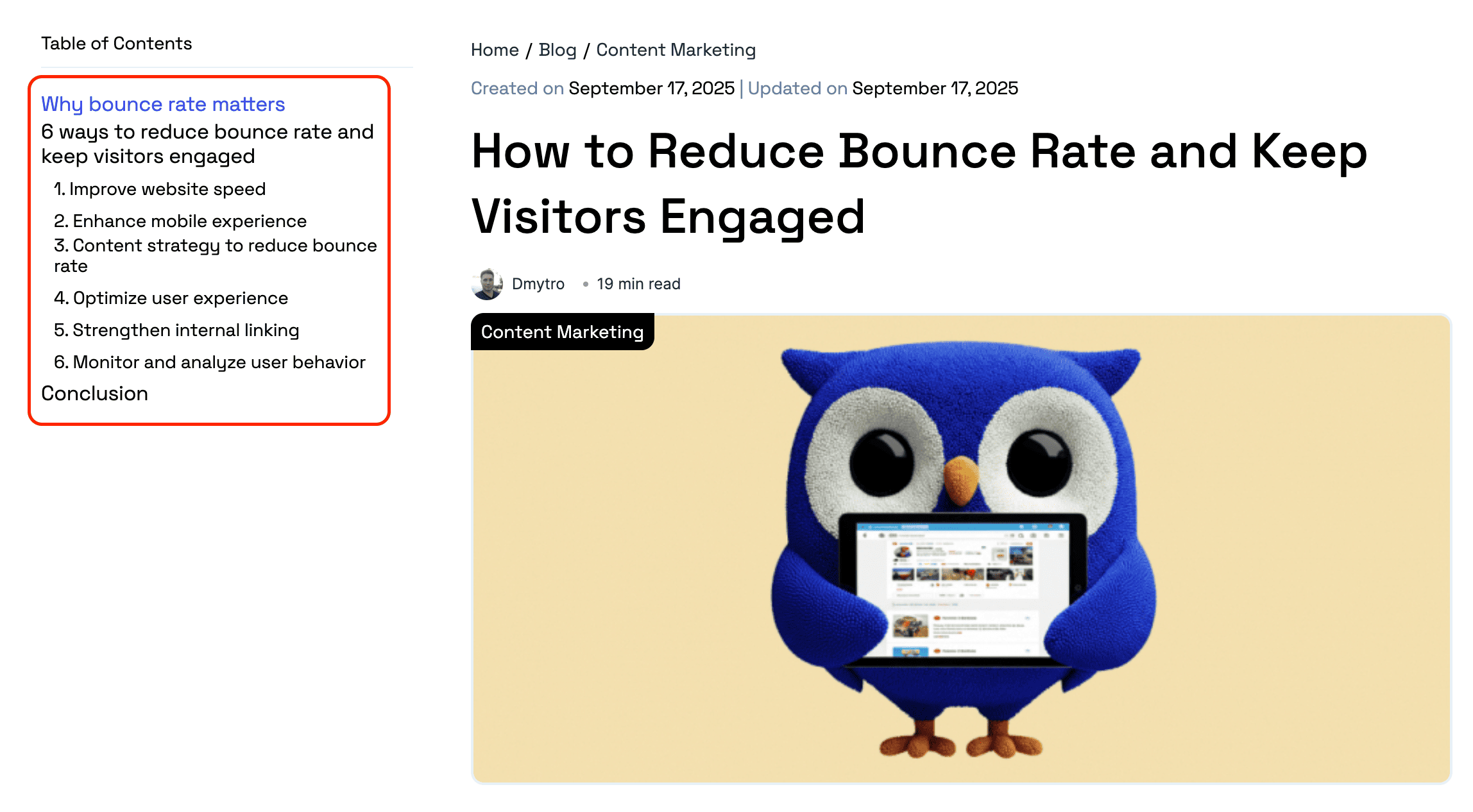
- And your structure needs to have clear steps, tips, techniques, tactics, strategies, etc., with clearly defined H2s and H3s.
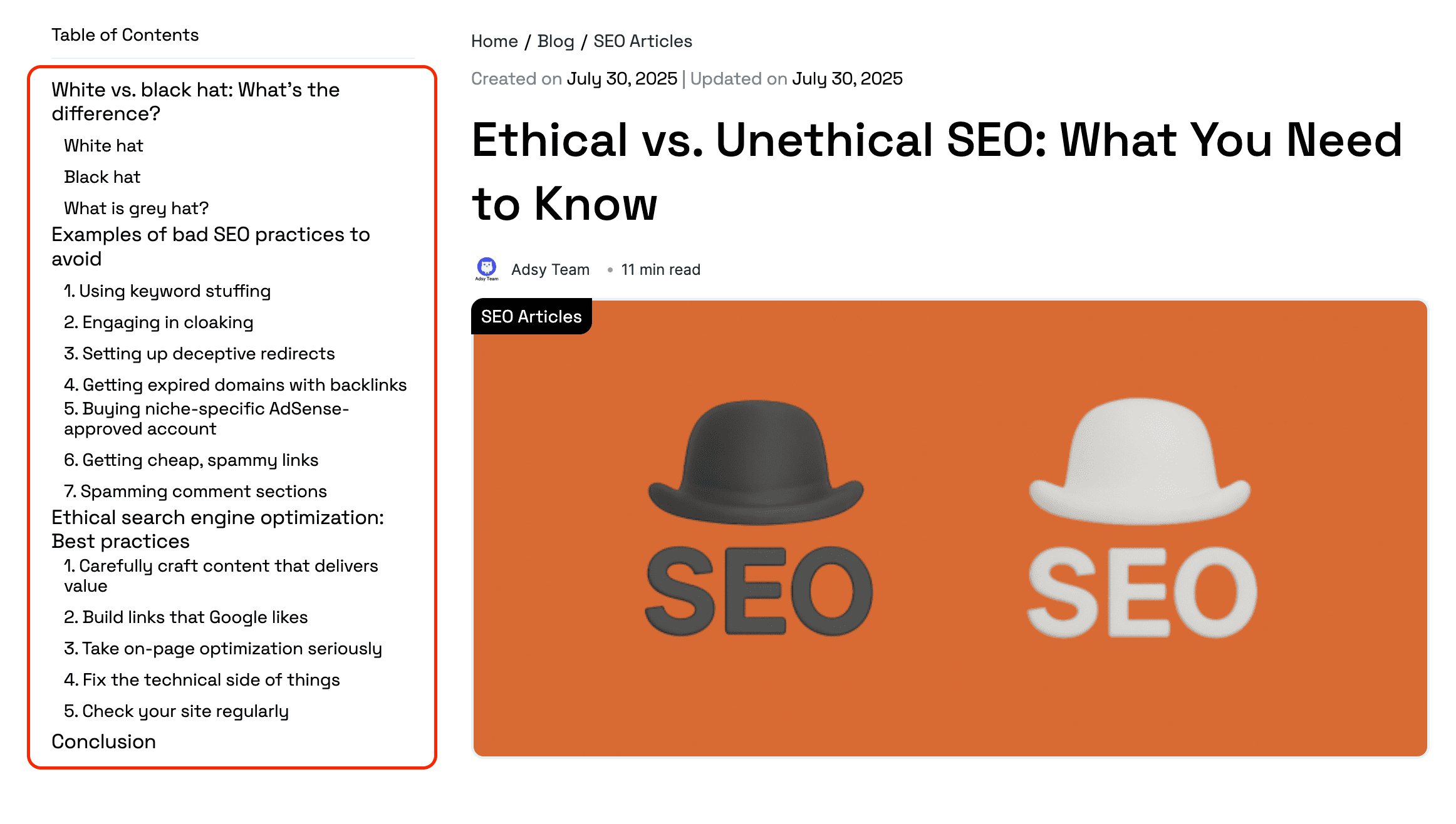
Complex or multifaceted queries
“How to build an SEO strategy for small businesses in 2026,” “Best AI tools for content marketing,” and similar “blah blah we’re explaining something important here ...”
Informational queries get a lot of attention from AI overviews. We’ve already mentioned this in the first point.
But these go one step further. They address complex questions from multiple sides, giving a full overview of an issue, challenge, etc.
Here's a very important thing.
These queries often trigger AI search results because Google uses a “query fan-out” approach.
It basically “splits” your original query into multiple related sub-questions. And then, the AI algorithms synthesize the most accurate direct answers from relevant content.
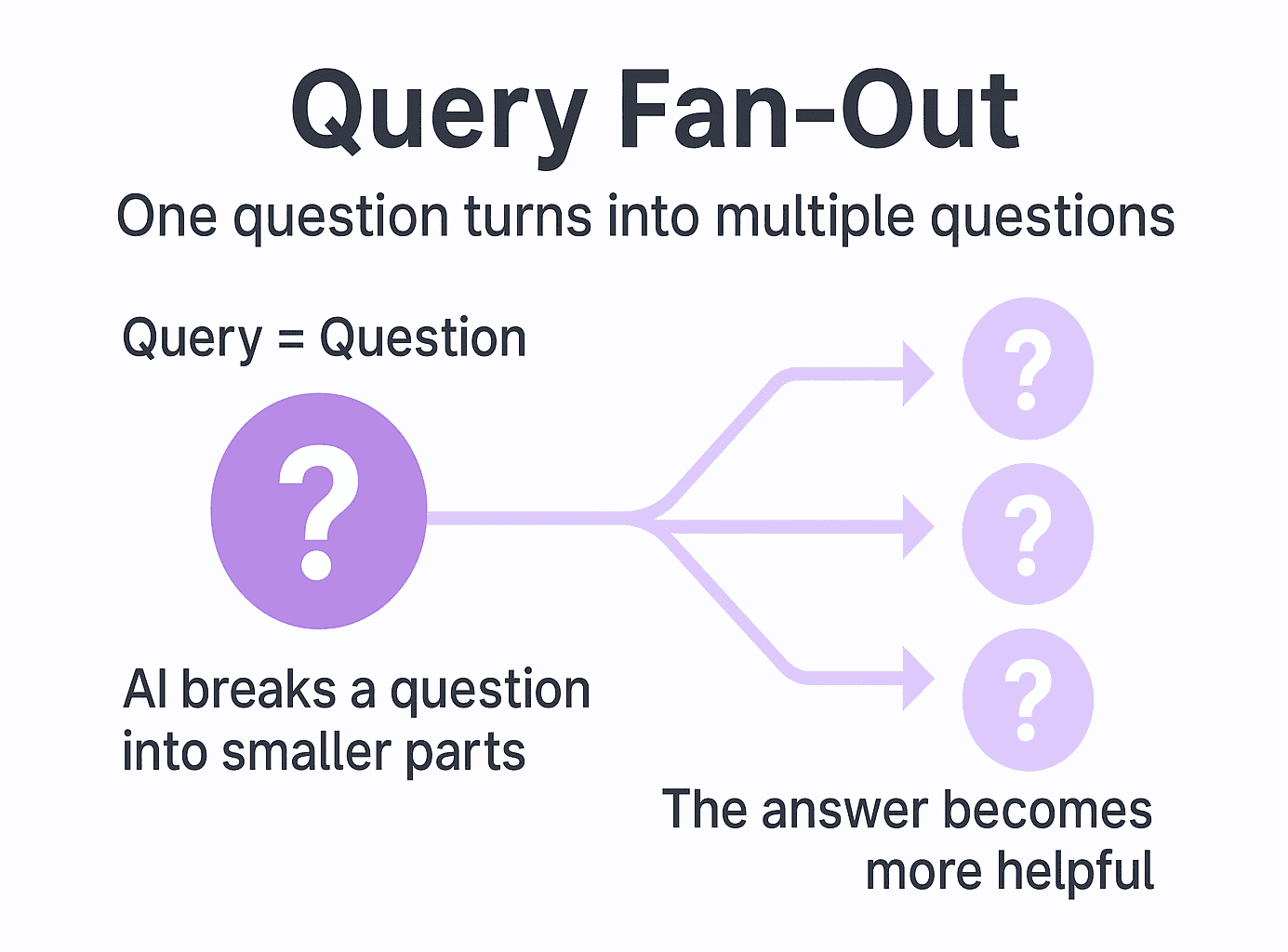
To be featured, your content should:
- Include structured data and clear headings so AI models can map each part.
- Maintain up-to-date and factual information to remain trustworthy in AI-driven search results.
- Address multiple user questions/intents in one post (the “what,” “how,” and “why”).
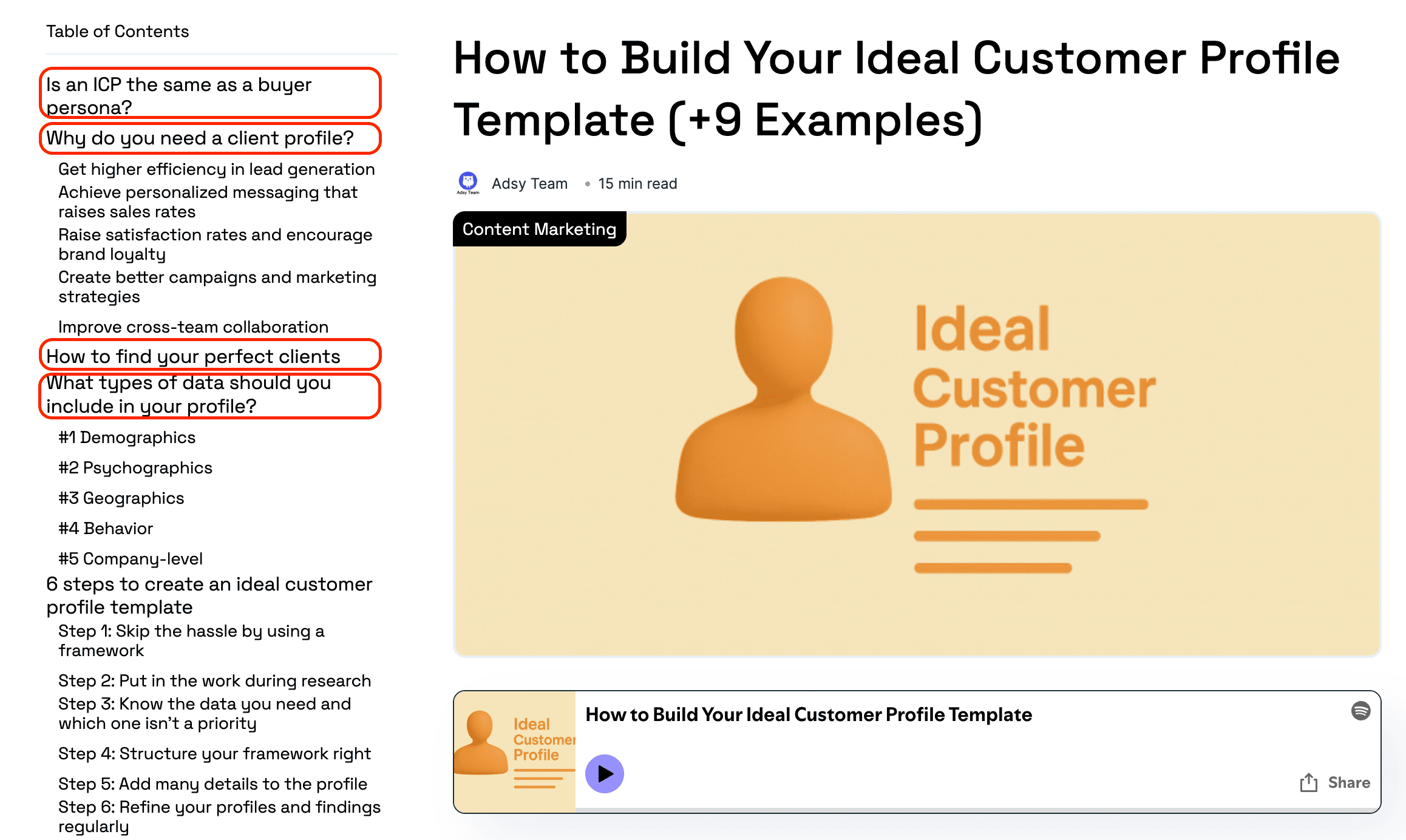
Again, as you see, it's a lot about structures. Oh, robots seek robotics, you might assume (and you won't be wrong).
Focused subpages and deep topical authority
Contrary to what some marketers assume, AI Overviews rarely pull information from homepages.
Instead, they cite focused “subpages” that directly target a particular user intent or informational query.
So, what helps here is:
- Dedicated guides or FAQs around one precise topic.
- Consistent technical optimization and schema markup.
- Topical authority built through relevant internal and external links.
- Topic clusters that show your expertise to search engines and AI models.
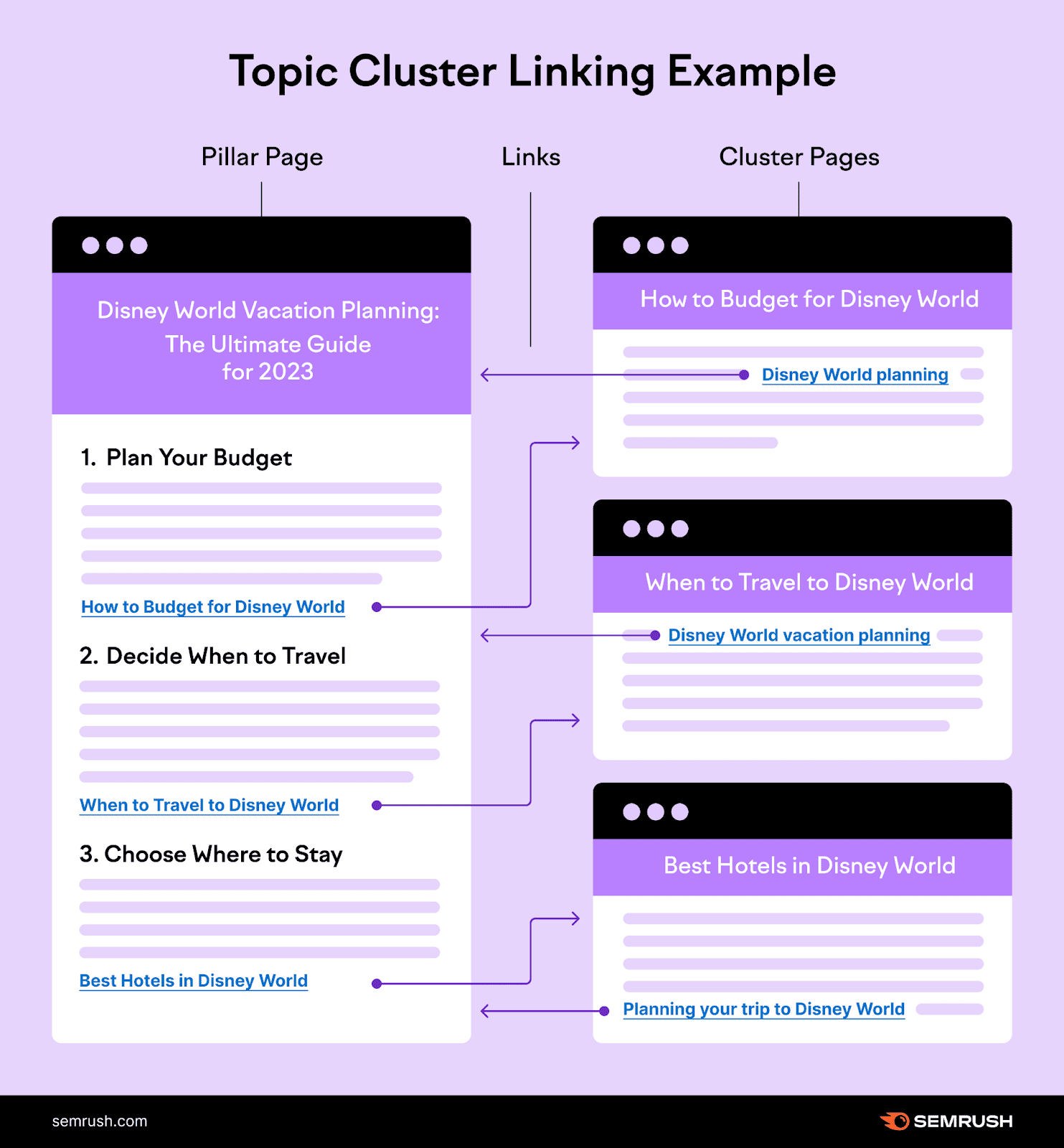
Source: Semrush
Here's a simple example.
A B2B SaaS company is much more likely to rank in an AIO for “best CRM workflows” if it has a laser-focused blog post covering this exact topic.
But their broad “Our CRM Features” product page probably will never make it to the overview.
Multimodal and interactive content
Google’s systems increasingly pull from multimedia sources. YouTube videos, embedded charts, and even social threads can all help you show up in the AIOs.
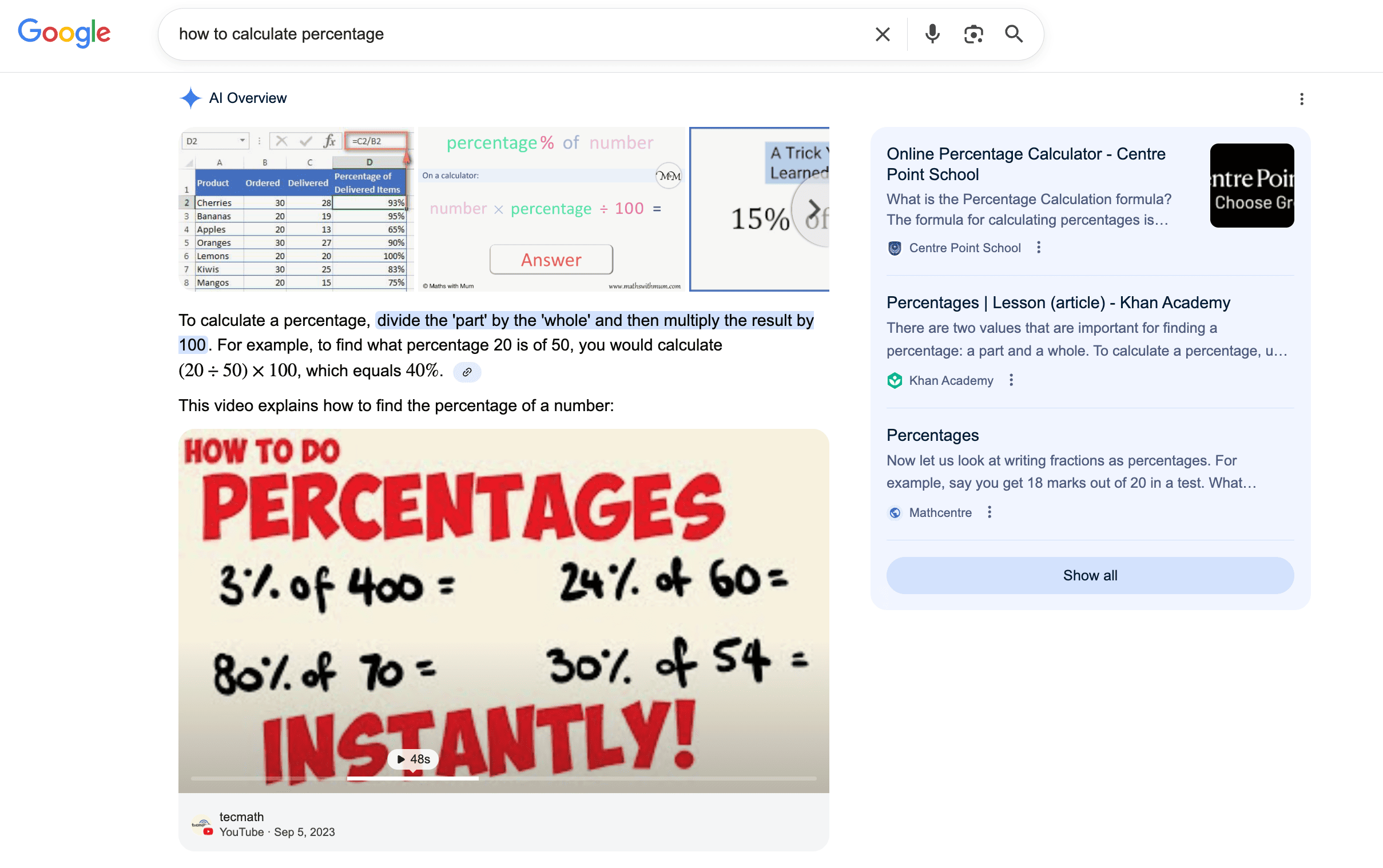
But... Don't rush to dust off your camera just yet. Even video-based content needs strong text anchors to be understood by AI algorithms.
That's why if you go for videos, you need to:
- Add transcripts or detailed descriptions that summarize your video (preferably with keywords).
- Use structured data like VideoObject or HowTo schema (if it’s a how-to video).
- Include contact details and local signals for local SEO queries (if relevant).
Your content might be visual. But it should also be machine-readable and optimized for AI-driven search visibility to serve here.
8 tips to optimize for AI search results
Now comes the most important question: how to rank in AI Overviews?
You already understand how they work. So, you have a general idea about what you need to do for generative engine optimization.
Yet, let's make it more tangible and easier to apply.
Before we start, it would be smart to first see what Google has to say about this:
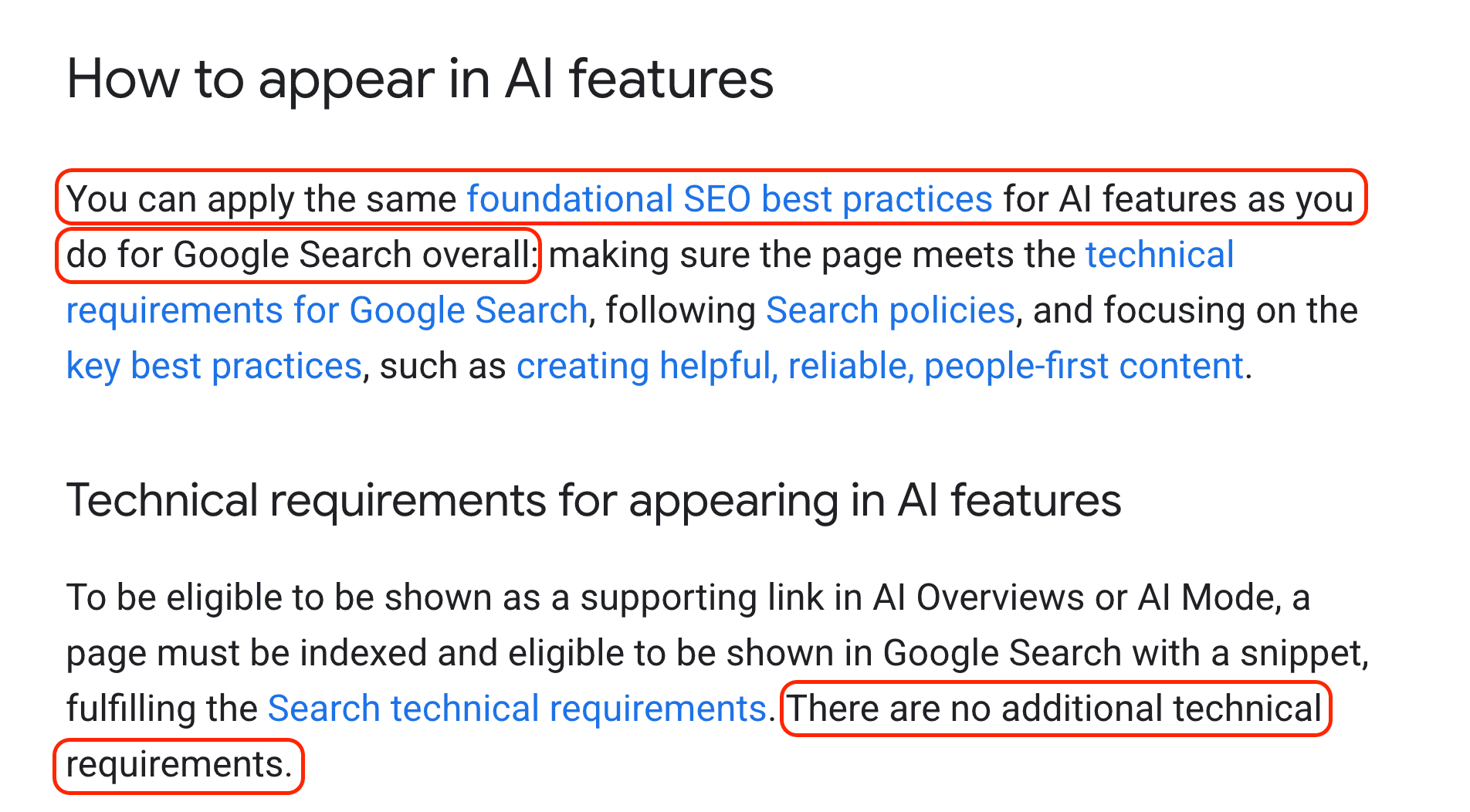
Source: Google
Yes, you read that correctly. You can basically focus on your “normal” SEO and get featured in AIOs.
But of course, this isn’t a precise checklist of things to do. That’s why most of the information we have by now comes from the logic of how AI works (what we’ve discussed above), expert observations, and personal experience.
So far, the following eight techniques are the most effective when it comes to ranking in AI Overviews.
1. Choose topics aligned with user intent
First of all, make sure the content you publish aligns with the search intent.
You can check this in any SEO tool and by going through other pages that already rank well for your target query.
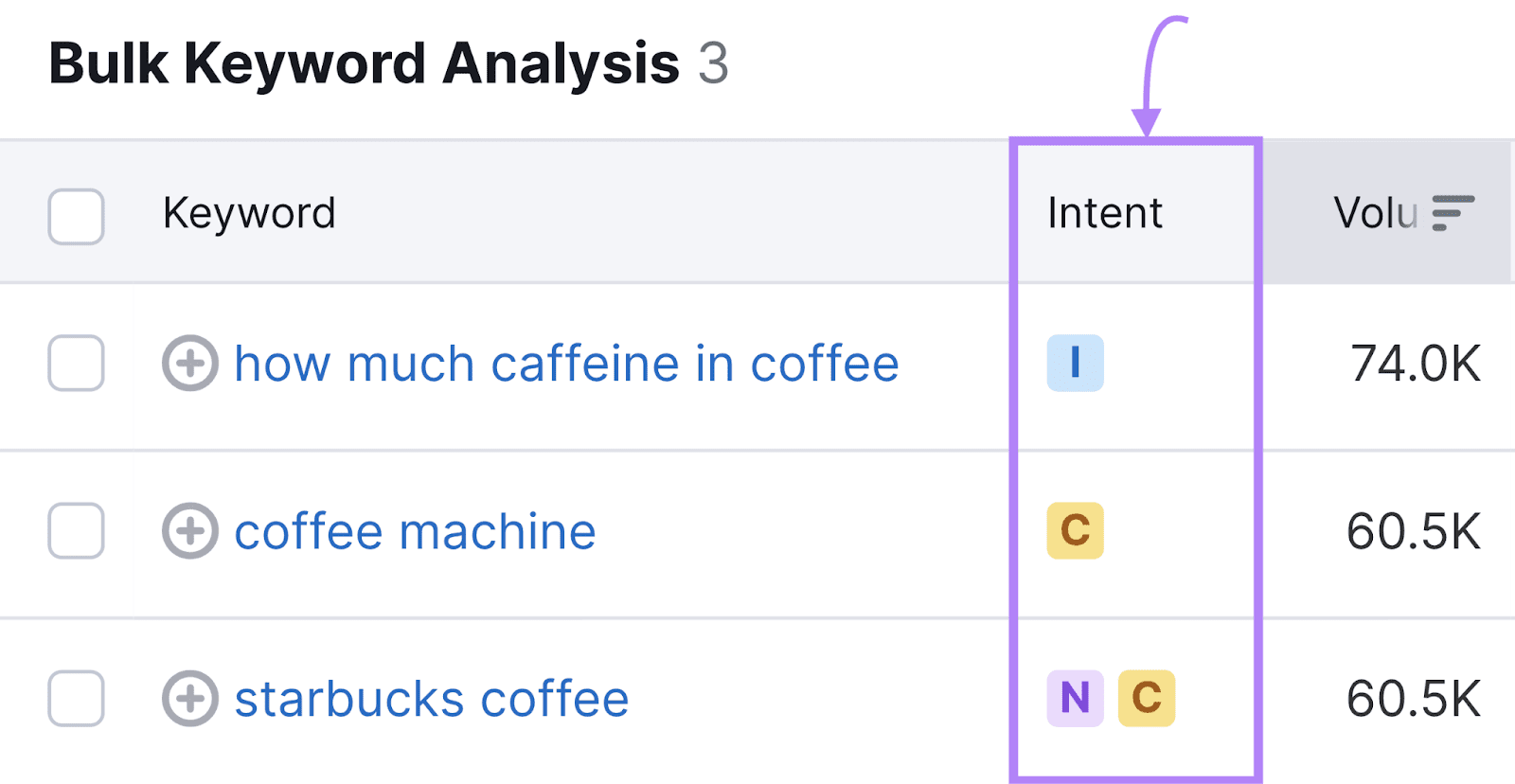
Source: Semrush
Why does it matter?
If you think about it, when Google creates AIOs, it always “wants” to give users the exact answer they’re looking for.
So, if a person is looking for places to buy winter tires and you give them a guide on how to pick those tires, you’ll never get featured for the obvious reason.
Some other things you could prioritize are:
- Target informational queries or complex user queries. With them, you generally have better chances than with purely transactional or brand-only ones.
- Use long-tail keywords and anticipate follow-up questions. This boosts your chance of being referenced in AI-generated summaries simply because you’re more precise.
For example, you can write generic “SEO tips”. But these will likely never get into the overview, especially if you aren’t one of the top websites in the niche.
So, you'd better use “how does schema markup help in SEO” or “how to optimize for AI Overviews in 2026” (you see what we’re doing here, right?:)
2. Structure content for AI models, but don't forget that actual people will read it
If you want to conquer robots (aka AIOs), you have to think like a robot, or well, at least pretend to.
Google's AI Overviews are formed by their generative models. And they don’t perceive the information like we do. So, you have to structure your content accordingly.
Still, the ones who will actually read your posts are humans (hopefully), so you have to balance both.
You’ll see that your readers will also benefit from most tactics that help you with AIOs' rankings.
So, it’s a win-win. For example:
- Go for direct and clear language. Your ideas have to be straightforward.
- Use short paragraphs, bullet points, numbered lists, clear steps, and tables. These formats help AI understand your content and make extraction much easier. But they are also great for your readers to catch the idea faster.
- Include H2s and H3s with clear question/answer style headings (“What is …?”, “How to …?”, “Why …?”). Your answer has to be direct and clear, preferably in the first 1-2 sentences after the heading.
- Embed structured data. This could be FAQ schema, HowTo schema, etc.
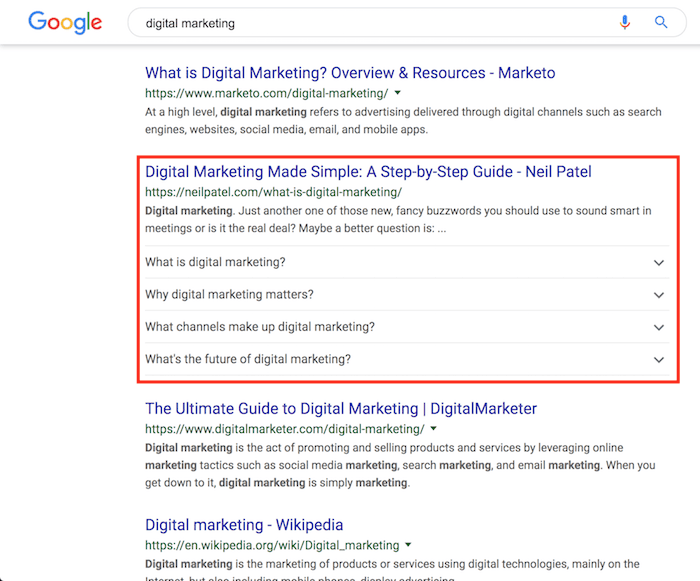
Source: Neil Patel
Still, all these things are beneficial even when optimizing for traditional organic search results.
So, it isn’t just about appearing in AI-generated summaries. It’s about improving your overall web performance.
3. Focus on fresh, valuable content and brand authority
We’ve already talked a lot about content and authority. But now, let’s sum everything up.
In the age of AI-generated content, the only way to stand out is to care about the following:
- Fresh and verified content. Mediocre blog posts don't live long these days. So, you have to keep your data, stats, and concepts up to date. Simply because inaccurate or outdated info is a red flag for AI and your readers.
- Brand recognition and authority. Since anyone can generate anything today, you have to be a true specialist with real-life experience in your niche. Because AI can’t have that. We could generate an article on quantum physics, but would it be valuable? Hardly. Yet, coming from a scientific journal, this information will have much more weight.

Source: Science Direct
- Your expertise and trustworthiness. The E-E-A-T system works here as well. Author credentials, citations, references to credible sources, and links to (and from) other high-authority pages are great and much needed.
And of course, do we even have to say that? Useless, generated content is a no-go because it isn’t high-quality by default.
4. Optimize for multi-source citations (aim to be one of many, not the only one)
Yes, in featured snippets, you aim to be the only source. But when it comes to AIOs, you want to contribute to a pool of reliable sources.
So, how exactly can you do that?
Short answer: interlink your content with other trusted pieces. But let’s elaborate here. As a part of your link-building strategy, it’s important to:
- Add internal links (to other related content on your site).
- Include external links (to other credible websites that contribute to your piece).
- And after publishing, ideally, you want to get backlinks to your content to give it more weight. You can do this through collaborations, guest posting, press releases, and other types of distribution. Or you can simply use Adsy for your content marketing.
If you check pretty much any valuable piece of content, it will have all three types of links.
For example, let’s take this source from the AI Overview:
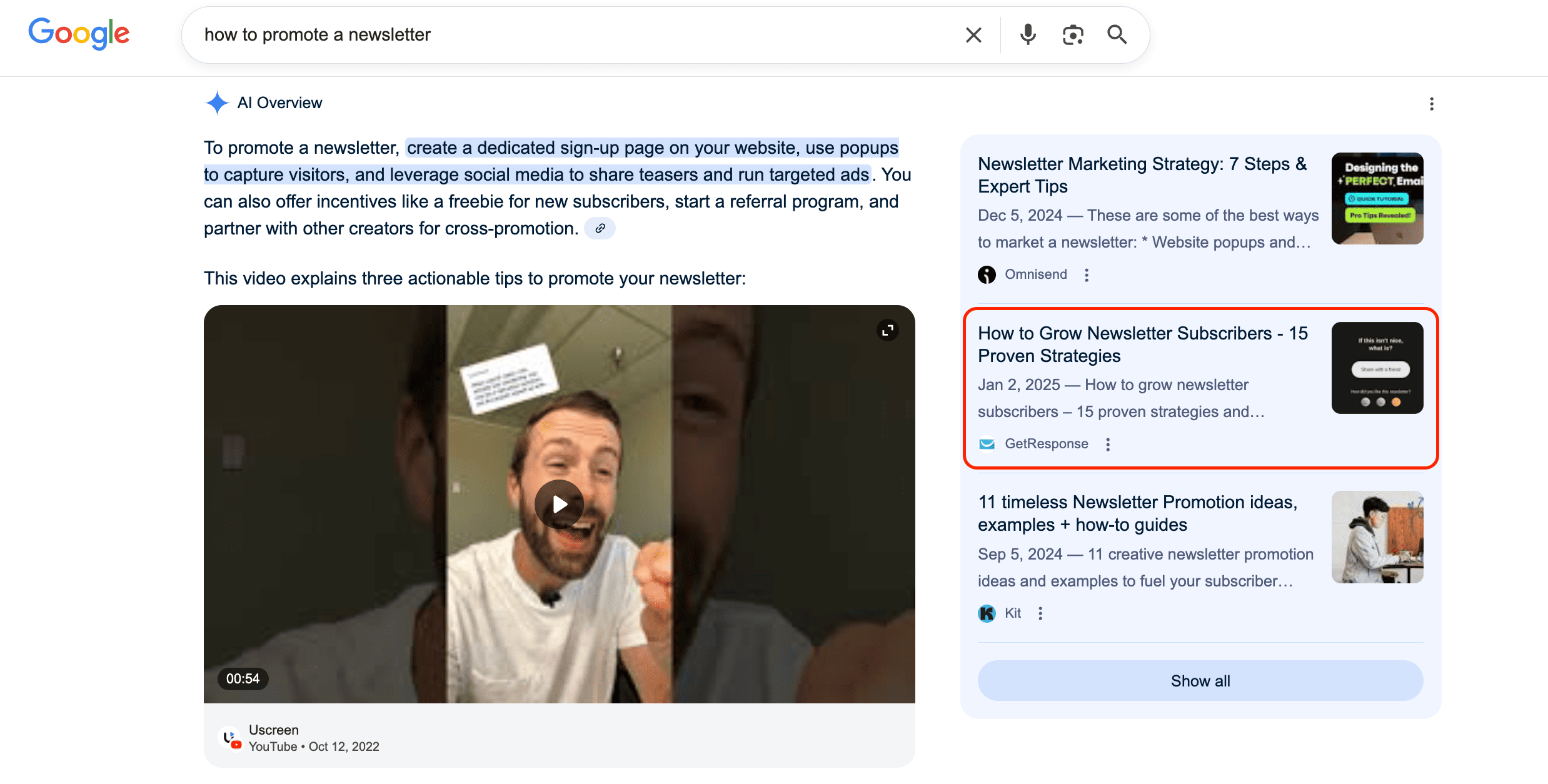
Obviously, they have internal links:

Source: Get Response
As well as external ones:

Source: Get Response
And guess what?
They also have some backlinks from relevant pages. Not too many, actually. So, sometimes, you don’t really have to obsess too much about these (depending on your query).
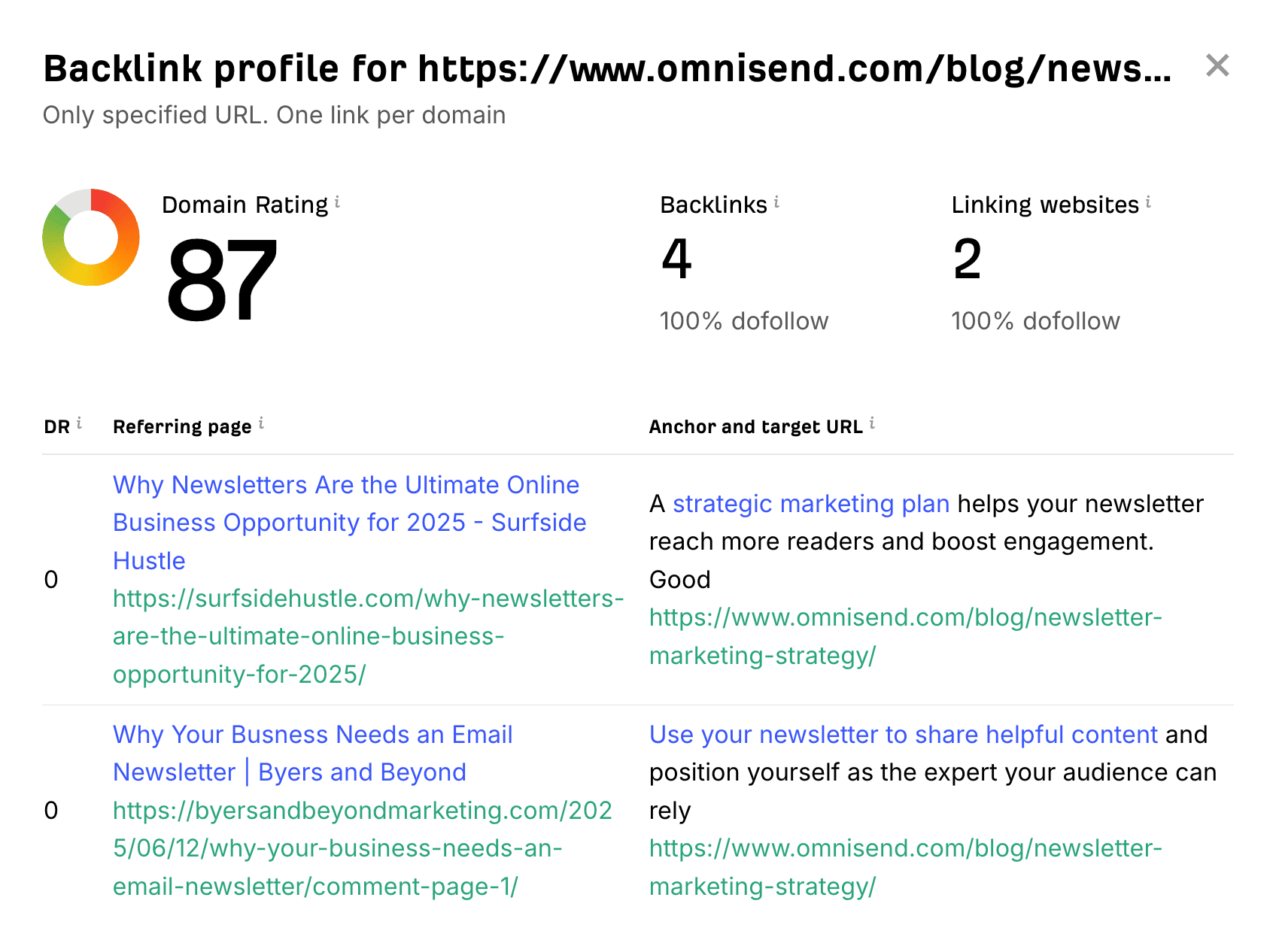
Source: Ahrefs
5. Make your content scannable and context-rich
Just like we mentioned above, AI loves scannable formats.
Let’s be honest, most of your human readers are also just scrolling through your pieces. Yes, the attention economy is kinda rough.
So, ideally, you want to stick to the following rules:
- One idea per sentence, paragraph, and section. Don’t try to mix everything together. Instead, add more subheadings, smaller sections, and brief sentences.
- Begin or end each major section with a concise takeaway sentence. This is optional, but generally, it’s a good idea to keep in mind. It helps both search engines and people to see your point clearly.
- Avoid fluff as much as you can. When looking at your writing, try to edit out everything that doesn’t add value.
- Support your content with examples, case studies, stats, and relevant visuals (preferably custom). All these add credibility and context to your pieces.
- Improve your readability. Use Hemingway to check how easy your articles are to read. Ideally, aim for a score around 5-6 (with nine as the upper limit). This writing is just much easier to digest.
If there were just one thing to prioritize for content scannability, it would be readability.
Because it will make you use simpler vocabulary and shorter sentences. And both are much needed for every business.
It could be different for some organizations or universities, though. Here is, for example, the World Health Organization’s article on mental health:
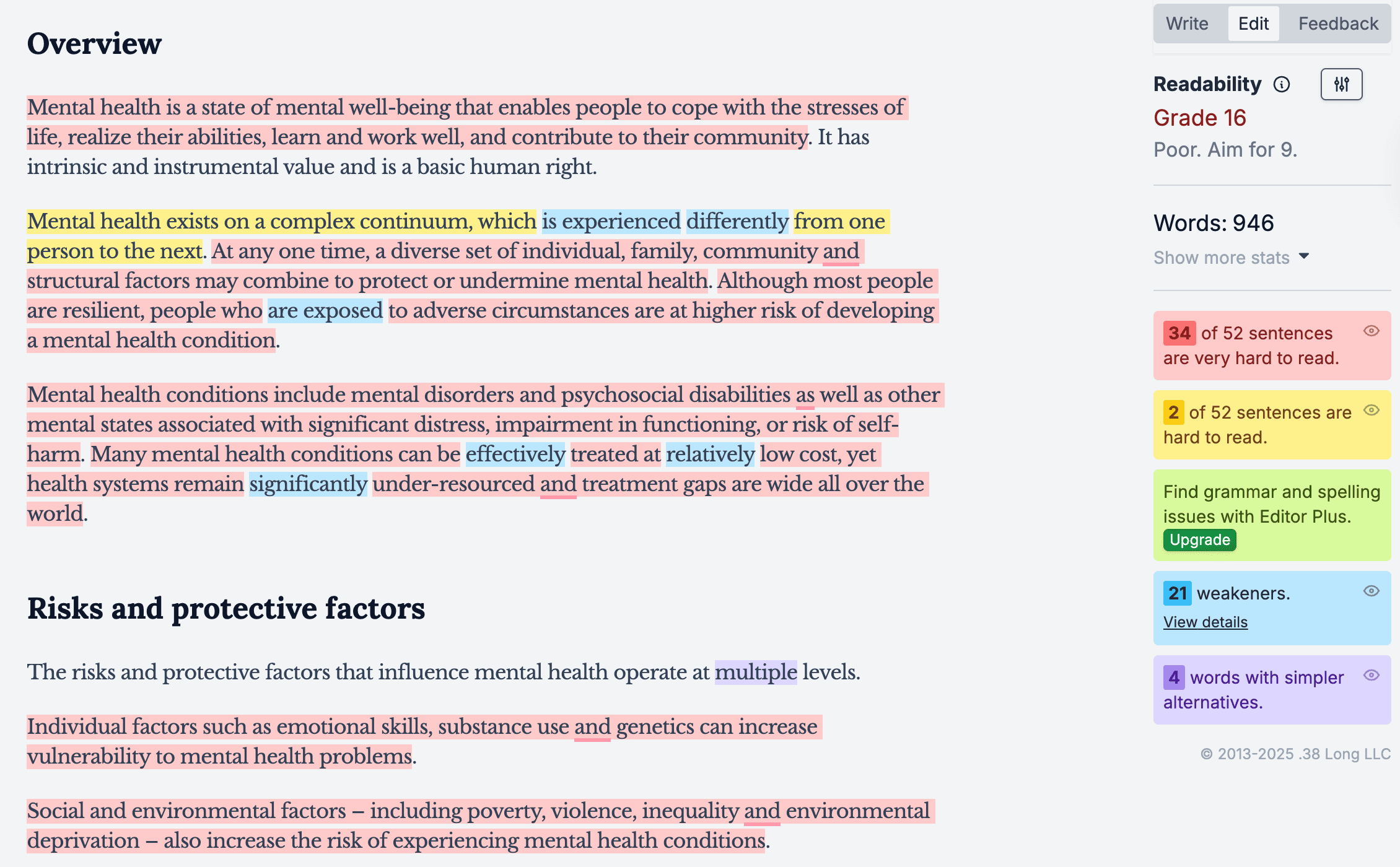
Source: Hemingway
Yes, the score is 16, and it’s way too high if we look at it from a marketing perspective.
For comparison, this is one of our previous articles. While the topic has some technical aspects to it (Adobe Analytics vs. Google Analytics), the readability is still on point.
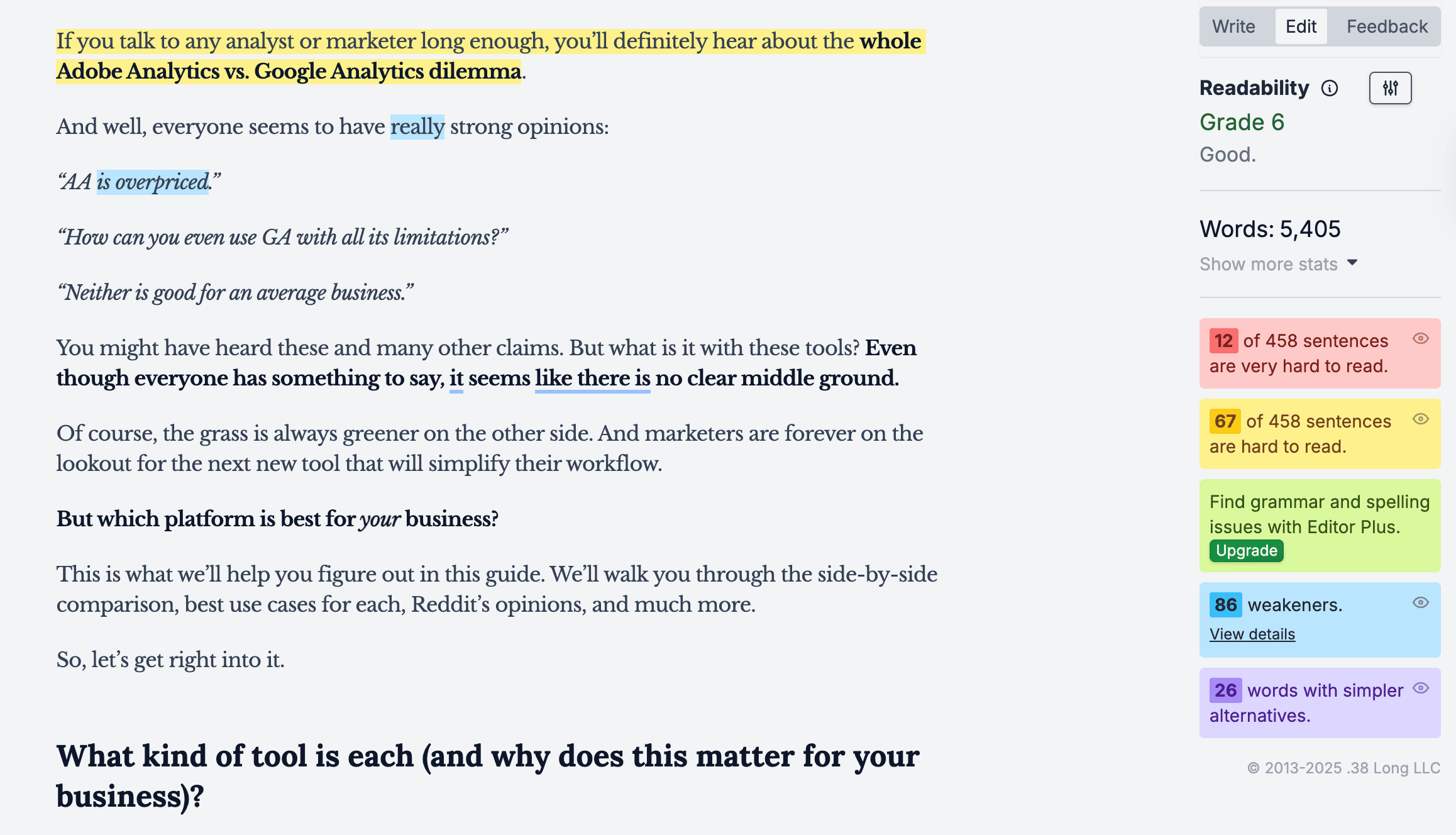
Source: Hemingway
6. Optimize for technical SEO and mobile performance
You might have noticed this by now. Even though optimization is evolving, most traditional SEO best practices aren’t going anywhere.
So, whether you like it or not, you’ll still have to work on your website’s performance.
Yes, technical SEO might be boring. But for Google, it is still an important factor to decide whether to show your website in the usual search results or AI answers.
What should you focus on when it comes to technical SEO?
There are dozens of things you can do, but these are the non-negotiables:
- Page load speed. Of course, high speed is a must. Whenever you start thinking that it isn’t that important, remember this Google stat. The probability of bounce increases 32% as page load time goes from 1 second to 3 seconds. Losing 1/3 of potential leads because of 2 seconds is kind of wild, isn’t it?
- Mobile-friendliness. Again, let’s check some stats. Almost 57% of users choose their mobile devices for search. Do we even have to mention what website version to prioritize?:)
- Security. Your site needs HTTPS. Most web pages have this by default, but if yours doesn’t, this should be the first thing to fix.
- Crawlability and indexability. You have to always keep an eye on whether your pages are crawlable and indexed. For this, submit sitemaps, fix your redirects, build a logical site structure, create clear URLs, etc.
And if you want to go deeper into this, you can check our technical SEO checklist to cover everything. Tech SEO continues to be a must, even if it seems less relevant than trends, AI optimization, quality content, and backlinks.
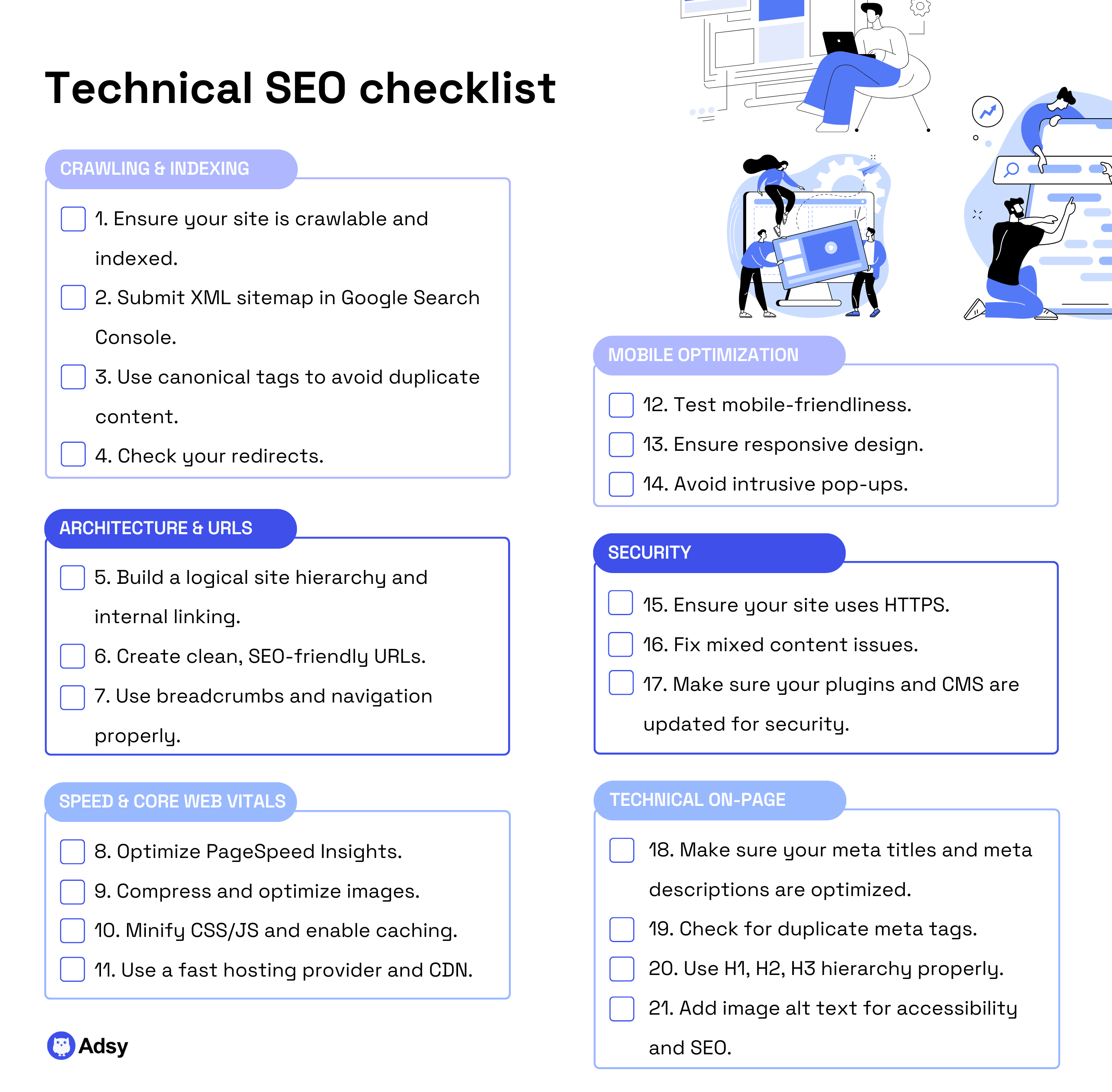
7. Monitor and adapt using AI-centric metrics
Monitoring and adjusting is a classic step. And you need it everywhere, far beyond just SEO.
As they say, you can’t manage what you don’t measure. Can you really argue with that?
So, first, check how you’re doing now. Do you already have any pages as AIOs sources? You can use any SEO tool to check this.
Likely, if you’ve been doing at least some SEO, you’ll likely have at least a couple of mentions. Even if you haven’t been optimizing specifically for AIOs.
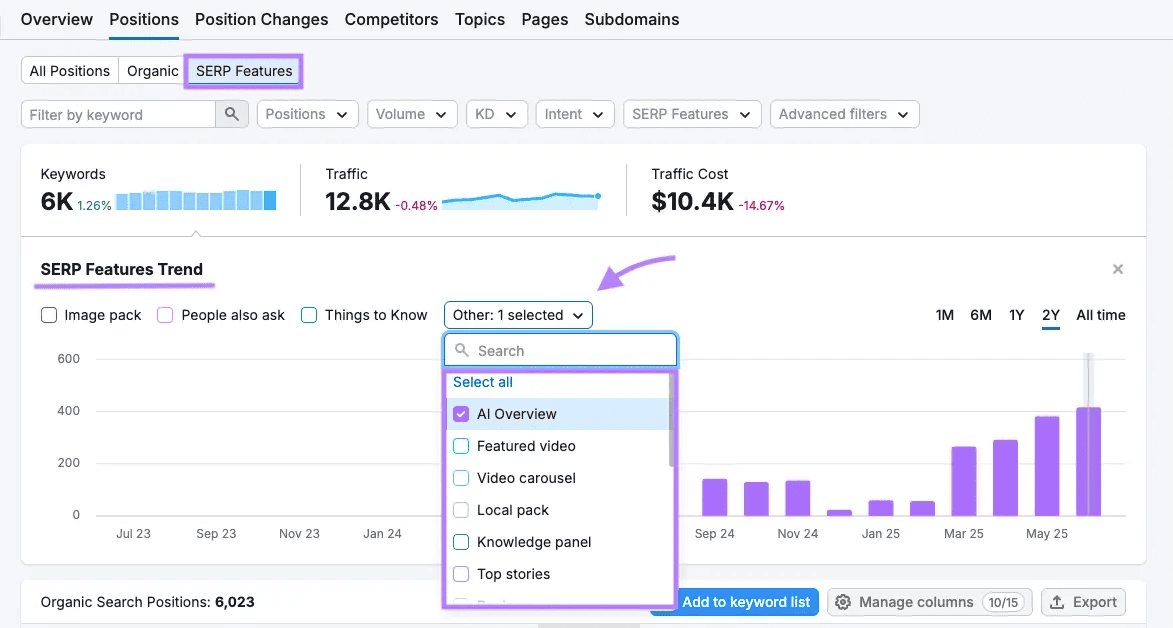
Source: Semrush
After that, do the following:
- Go through your competitors’ analytics to see their performance.
- Google your target queries to check what type of content gets cited. This should give you a good idea of what to aim for.
- Check your current content to see whether you can optimize anything already published.
- Next time, when doing keyword research, remember what we’ve already discussed: not every keyword will trigger AIOs. So, if this is your goal, choose your new topics based on the advice above.
If getting cited in AIOs is one of your new goals, just add it to your typical SEO KPIs and make sure to monitor your results regularly. When this becomes your routine, you’ll see that getting mentioned is much easier than it seems.
8. A stop list: What should you avoid?
Of course, in order to get cited in an AI overview, you need to know what NOT to do as much as doing the right things we’ve just described.
Here is your fundamental stop-list:
- Stop stuffing exact-match keywords.
- Stop publishing ultra-short “snippet bait” pages.
- Stop relying on list formats that lack depth.
- Stop blocking snippets site-wide with nosnippet.
- Stop assuming featured-snippet wins guarantee AIO inclusion.
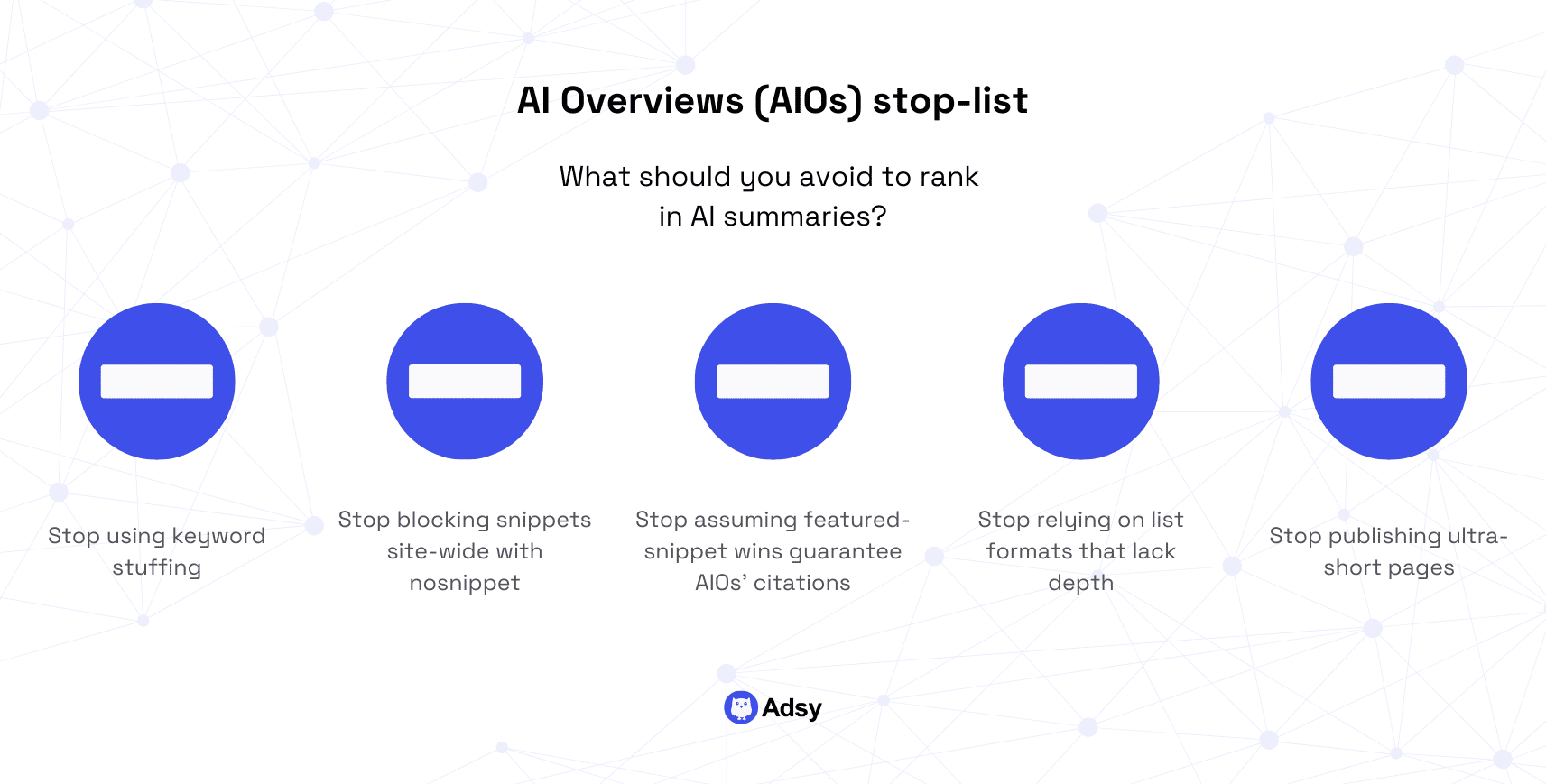
Now, let’s look at each of these in detail.
Avoid keyword stuffing
Keyword stuffing was a legit tactic. But was it like 20 years ago? Well, we might have lost track of time, but this doesn’t really matter.
What matters is that Google no longer favors or rewards this approach. So, avoid it at all costs.
These days, Google’s AI doesn’t even look for exact phrases anymore. It uses semantic search. So, it basically “understands” relationships between concepts and the overall context.
That’s why when you google “how to make Italian pasta with bacon,” Google will understand that you likely mean “carbonara.”
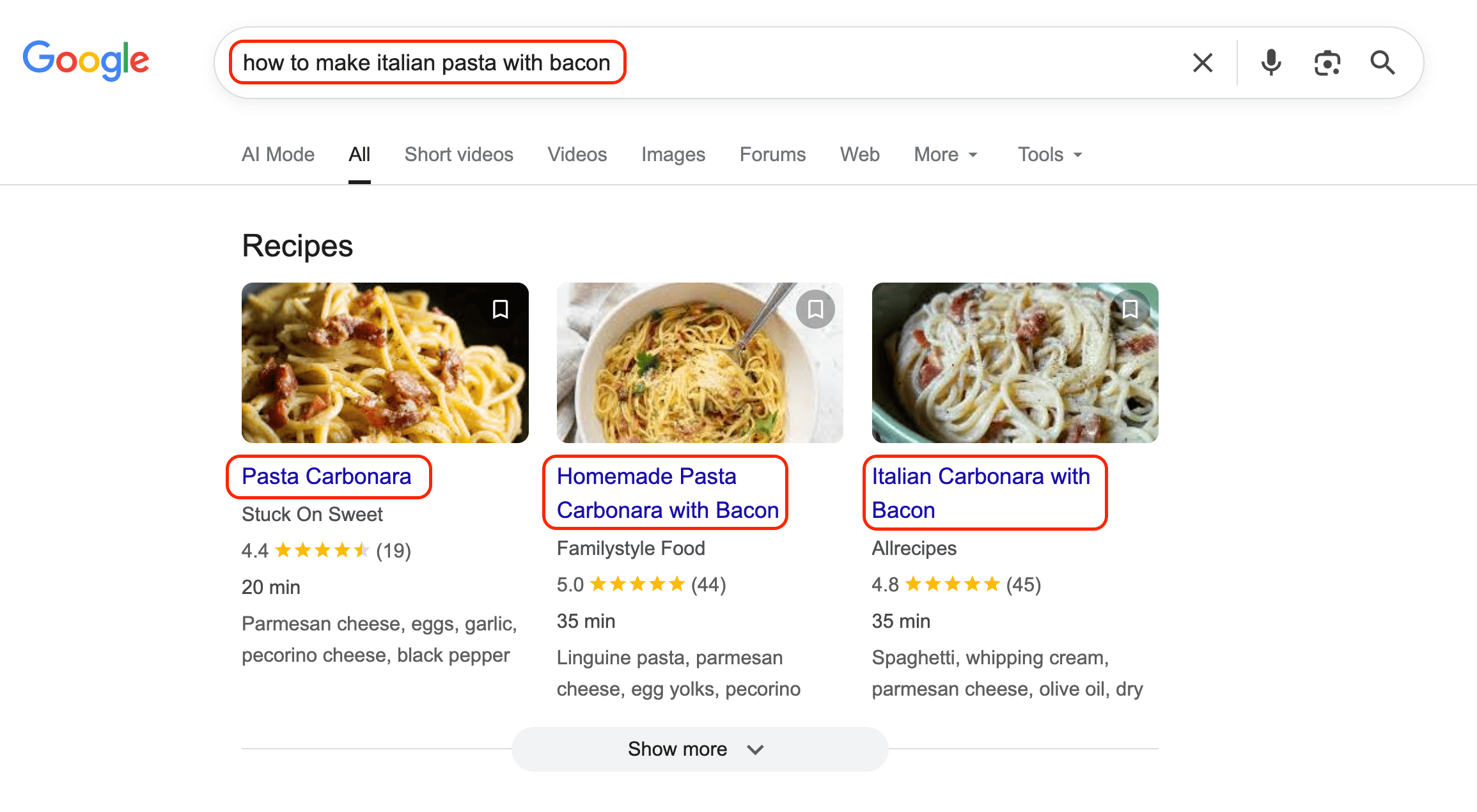
For our Italian readers, we’re sorry. We know that it isn’t bacon, but guanciale. But still, for the sake of example, we wanted to show how “smart” Google search really is these days:)
Besides, let’s not forget that you have to write for people, and stuffing keywords simply annoys everyone. And if it doesn’t help your SEO, either, why do that at all?
Avoid super short pages (300-400 words) and list formats that lack depth
We’ve connected these two points here because they’re ultimately about the same thing.
If you take a quick glance at AI answers, you’ll see that all of them typically have a short intro/definition paragraph and some concise bullet point lists.
So, it would only be logical to assume that if you create many short pages with some clear lists, you have more chances to get cited in AIOs. Plus, short pages are faster to write and often enough to win a featured snippet if the answer is simple.
Yet…
AIOs favor contextual authority. AI models want multiple “deep” sources. And it is pretty much impossible to get there when you only have 300-400 words and a short list.
AI models simply don't synthesize or cite shallow, short pieces.
Let’s take a look at a real-life example.
Here is an AIO for a very visual query: “how to create a moodboard”.
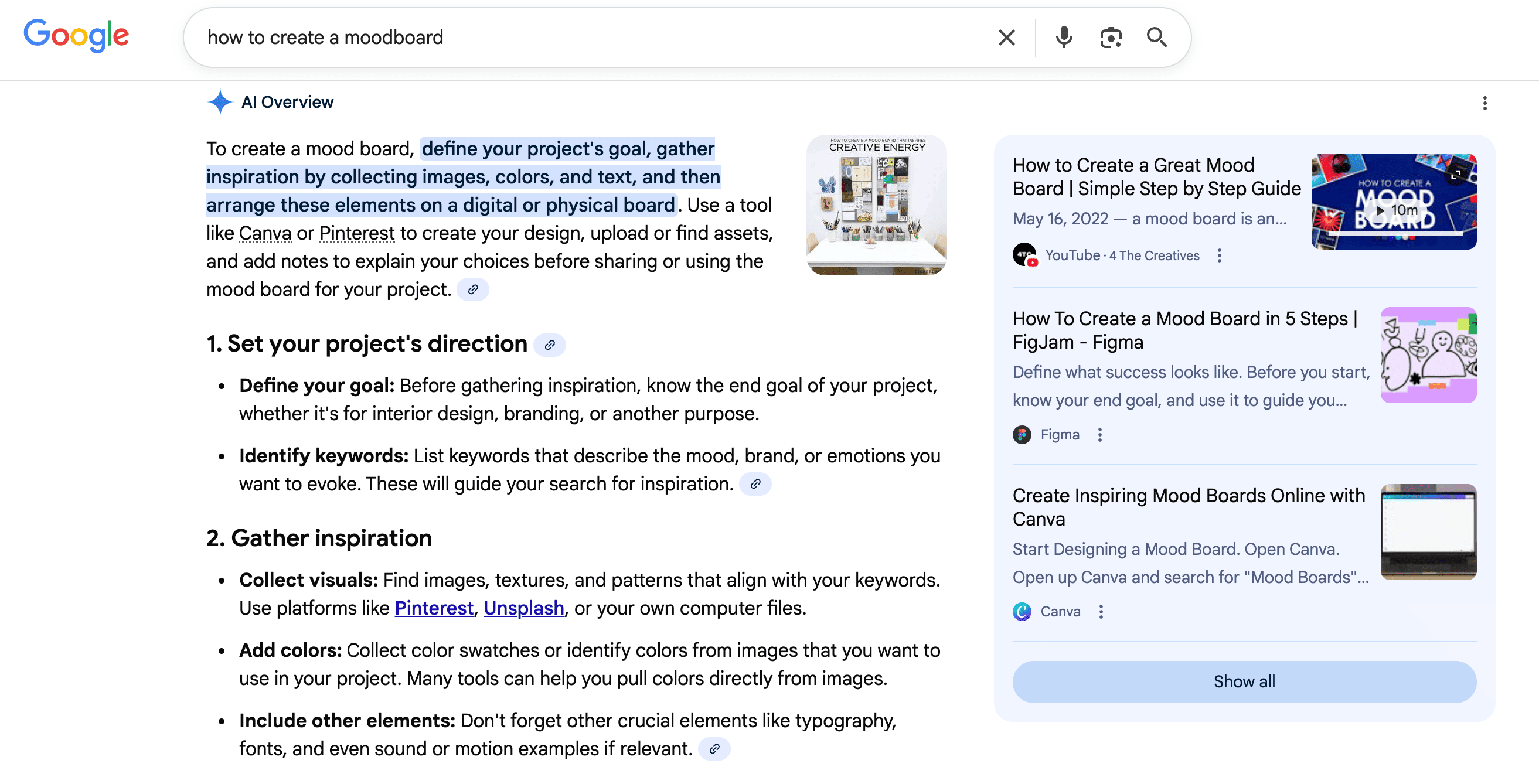
Even though it isn’t a technical, complex topic, if we look at the source pages, they won’t have 300 words.
First of all, the sources we see have extremely strong topical authority because both Figma and Canva are actual tools for creating moodboards and other visuals.
So, they have tons of relevant content and well-defined keyword clusters.
Now, if we check each page in detail, we’ll see that Figma’s article has 1,500+ words.
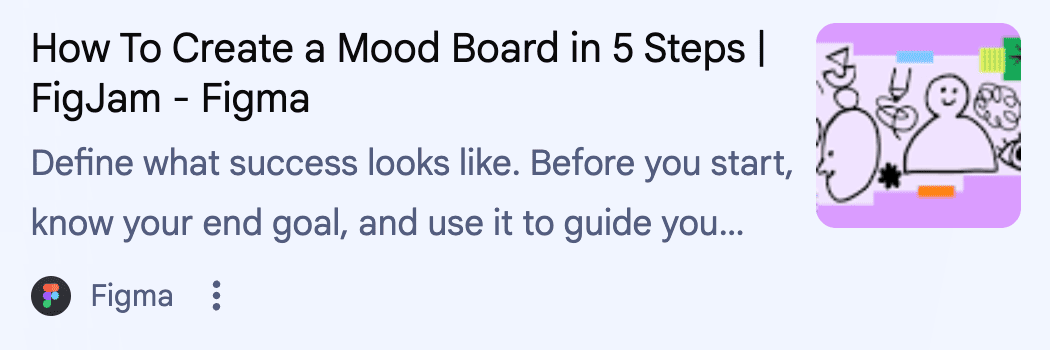
And Canva’s? Over 1,000, as well.
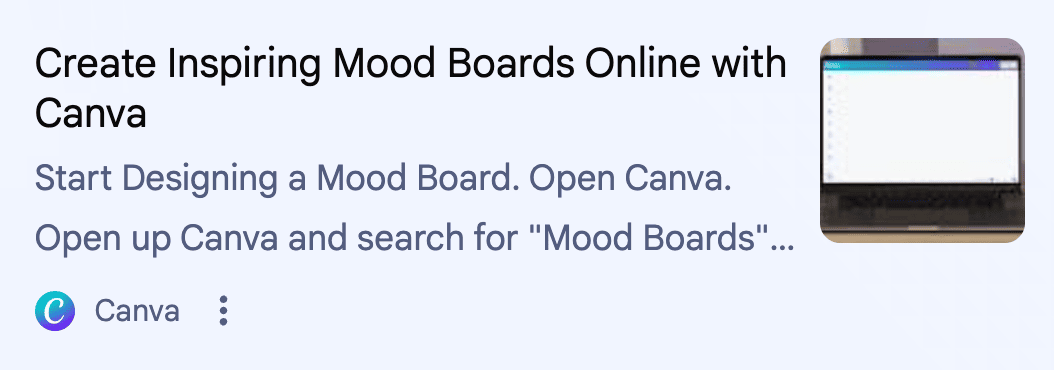
Now, imagine you want to cover a complicated topic on cybersecurity or even marketing and project management.
There is no way AIOs will pick a page that only has a couple of hundred words with some basic lists.
Besides, short pages are very unlikely to rank for multiple related sub-queries. That reduces your chance of appearing as one of the sources in the AI Overview even more.
Remember how we talked about the “query fan-out” approach? This is it.
So, what should you do instead?
Create pages that are focused but really deep. That means at least 1,200-2,500+ words with several related questions/doubts addressed. Depth is basically what allows you to cover common follow-ups, counterarguments, examples, or alternative approaches.
Apart from being really useful for SEO, it’s also a good way to gain content authority and strengthen your service or product positioning.
Avoid blocking AI with “nosnippet” or anti-bot tags
If you are one of those brands that uses nosnippet or max-snippet:0 for whatever reason, you won’t appear in AI Overview, no matter what you do.
So, if your goal is to get cited in AIOs, make sure you don’t use nosnippet sitewide.
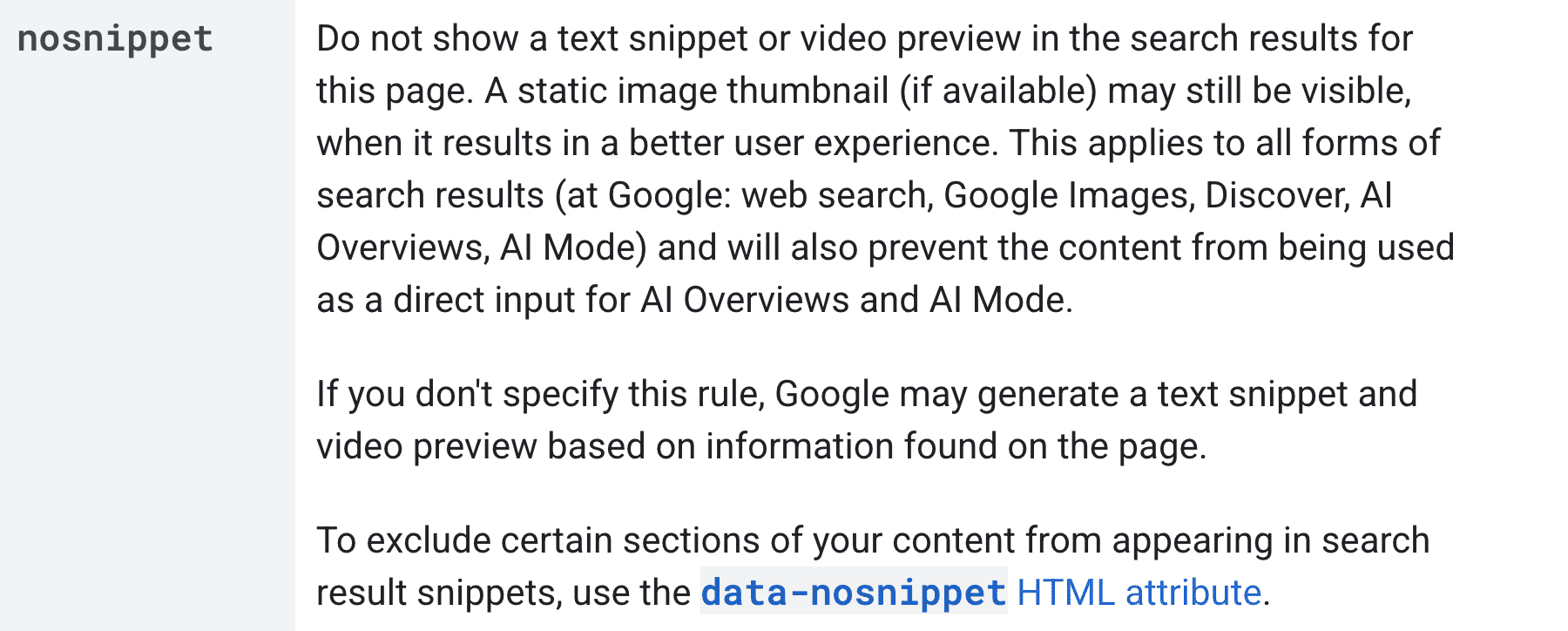
Source: Google
If you still need to use it for compliance reasons, to protect paywalled content, etc., apply it only to the pages that actually require it.
With page-level protection, Google can use the other content you have as a source for AI summaries.
Avoid relying only on past featured-snippet wins
We’ve already talked about featured snippets and how AIOs are slowly replacing them (or not so slowly, actually).
But it’s also important to mention that there's no transferability here.
If a page dominated “position zero” before, it doesn’t mean it will be widely cited in AIOs.
Why does this happen?
Mainly because featured snippets are about one extractable passage. But AIOs typically prioritize content depth, not just a direct answer.
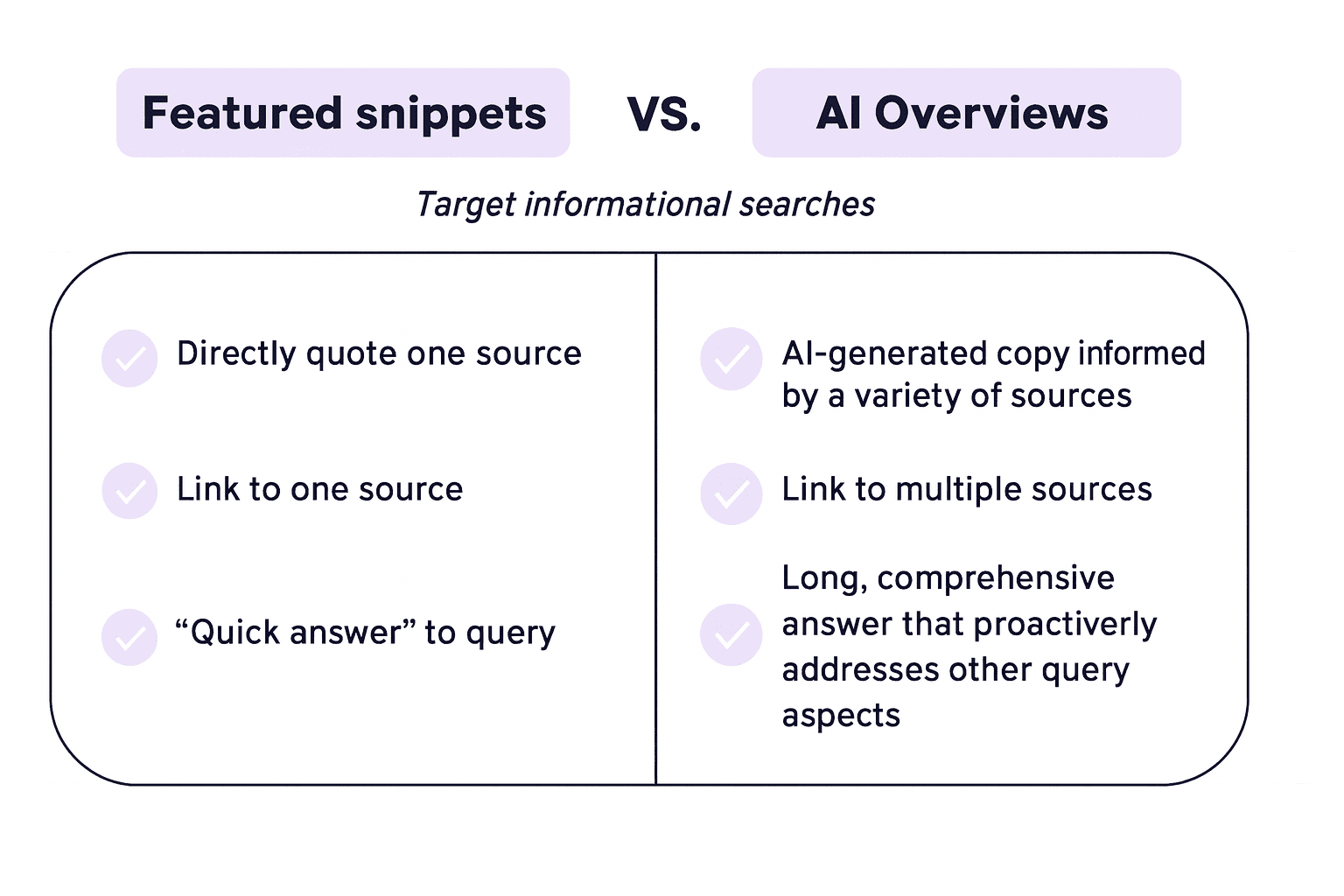
Still, if your website was previously getting lots of featured snippets, it means that you probably have some authority and decent optimization.
So, it should be much easier for you to optimize for AIOs. Just apply the tips we've listed above:
- You can start by updating your featured pages, expanding them, adding citations, including schema, and creating related content pages.
- You could also convert a snippet page into a “mini-pillar” that other pages can link to (when it makes sense).
Conclusion
AI Overviews have changed the rules of the search game. Yeah, we know that it sounds cheesy and sort of cliché. But it is true. If you want to get that new position zero, you have to adjust.
Yet, these new rules don’t change one thing. You have to write for people first. Today and always.
So next time, when you start optimizing for AIOs, don't forget that, in the end, you need to provide genuinely helpful information to your readers, not bots. And you’ll be fine.
FAQ
What Is Google’s AI Overview?
Google’s AI Overview is a feature in Google search that uses generative AI to create short summaries at the top of the SERPs. They pull information from multiple trusted web sources, combine it, and present a direct, conversational answer to the user’s query.
How long should an AIO-ready page be?
There’s no universal word count, but aim for focused depth. Statistically, you need 1,200-2,500+ words broken into scannable sections. Plus, it usually works best when it covers follow-up questions and addresses some related doubts.
How do I measure success for AI summaries?
So far, Google-native tools (Google Search Console and Google Analytics) don’t allow you to track AIOs directly. So, if you want to see the actual numbers, you need to use an SEO tool like Semrush or Ahrefs.
And when it comes to Google Search Console or GA4, currently, you can measure your AIO performance indirectly. You can, for example, monitor impression trends, rankings, engagement metrics, etc. Sure, it won’t give you a full picture, but at least you’ll see the tendencies.
Do AI Overviews affect SEO?
Definitely. While the connection is complex, some of the most visible outcomes are:
- The click-through rate (CTR) and organic traffic often drop when the query gets an AIO.
- Today, you can’t prioritize your rankings in search engines alone. You have to account for AI search rankings.
- You have to be smart about your content to avoid covering topics that are “zero-click searches”.
- Your authority and credibility matter more than ever, whether you want to optimize for AI summaries or traditional search engines.
